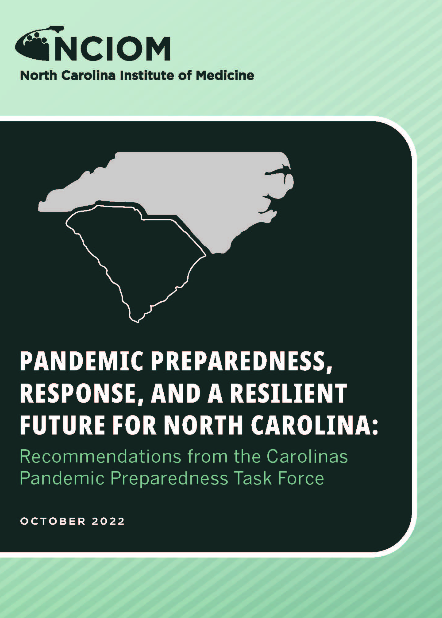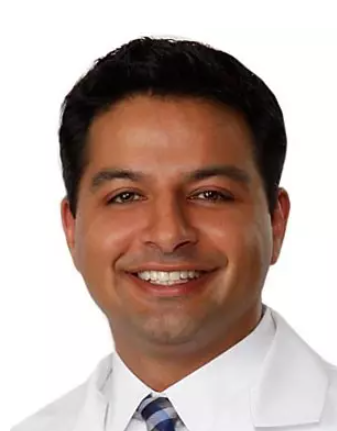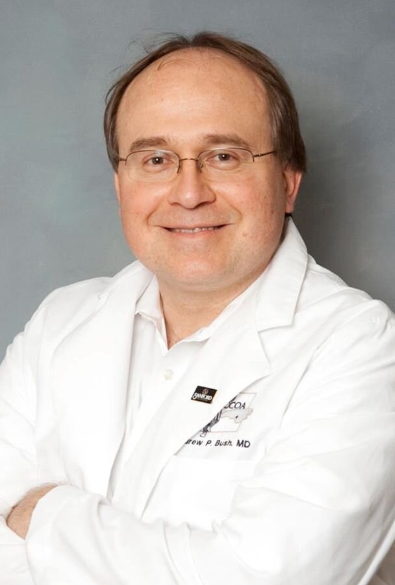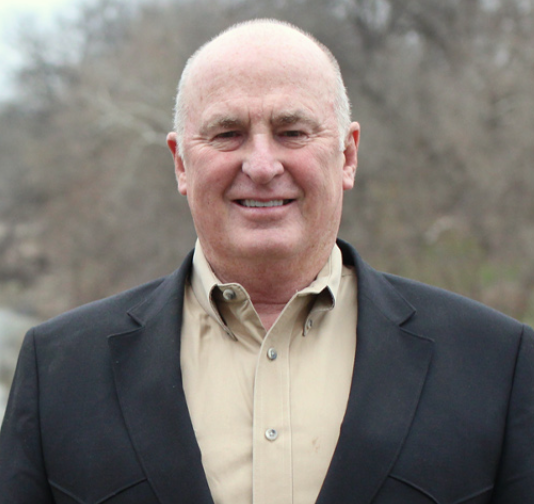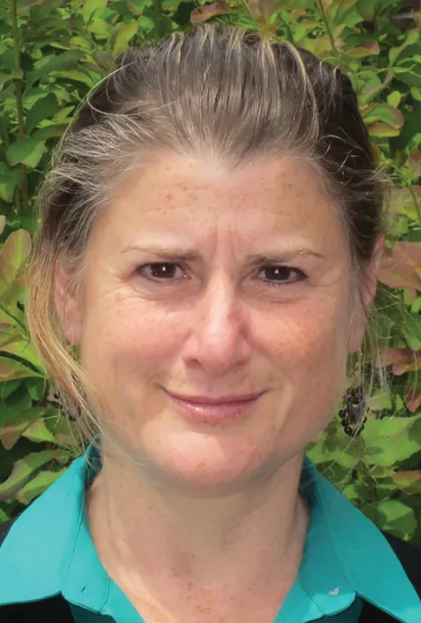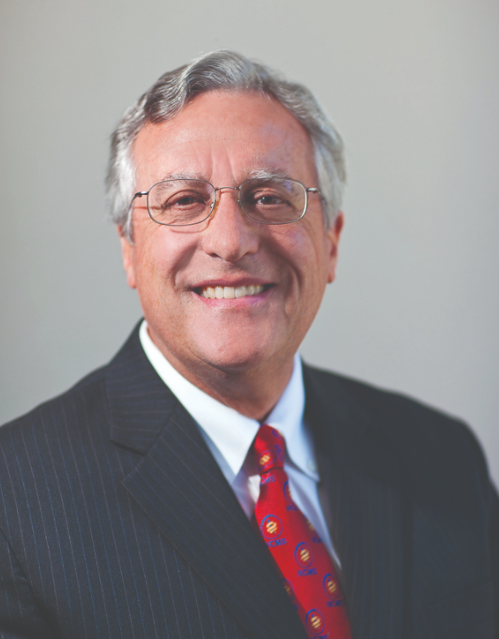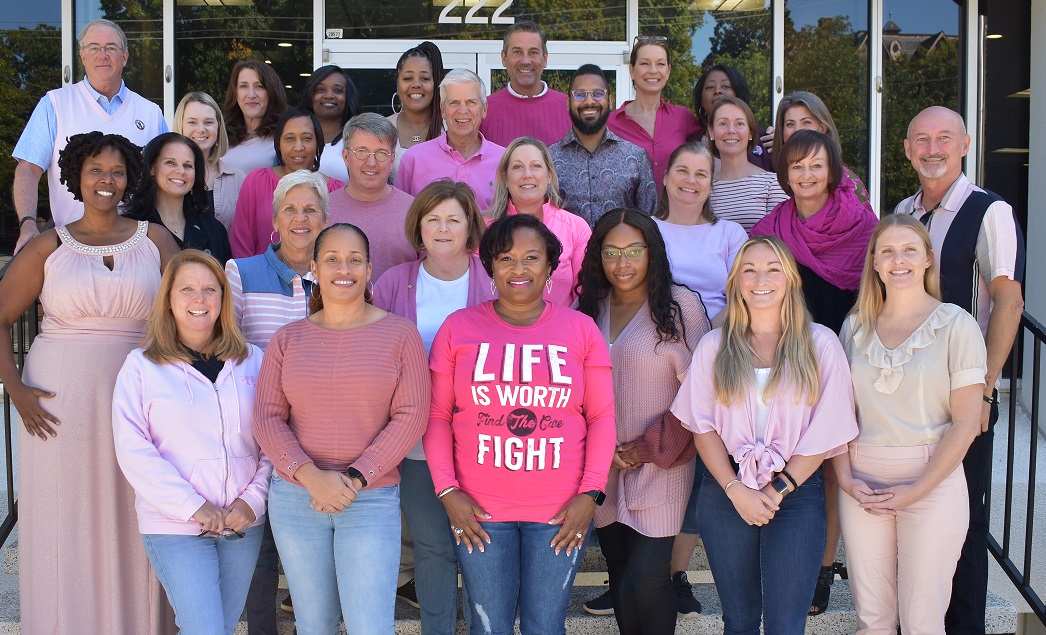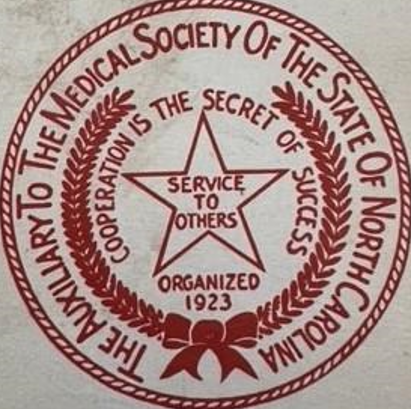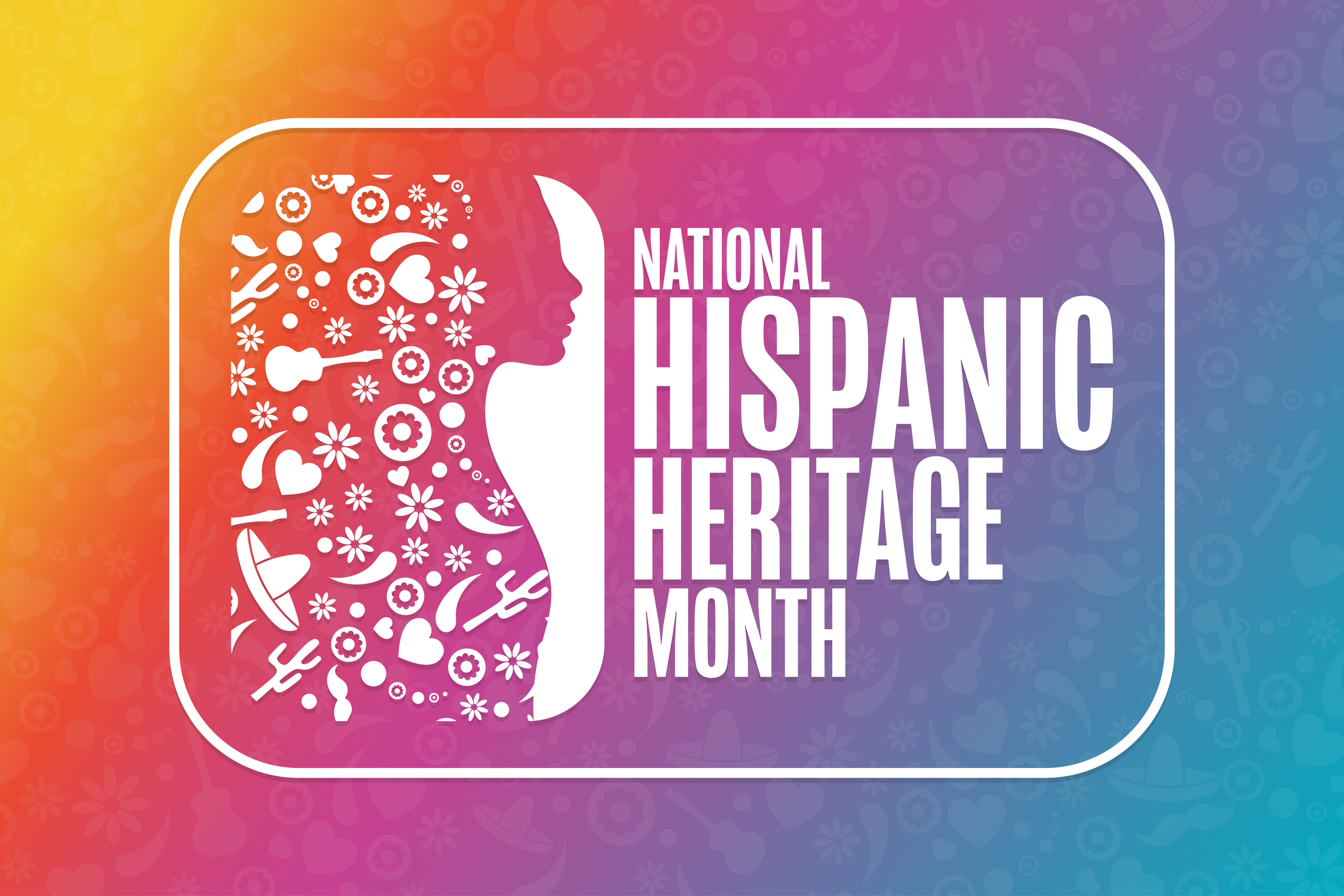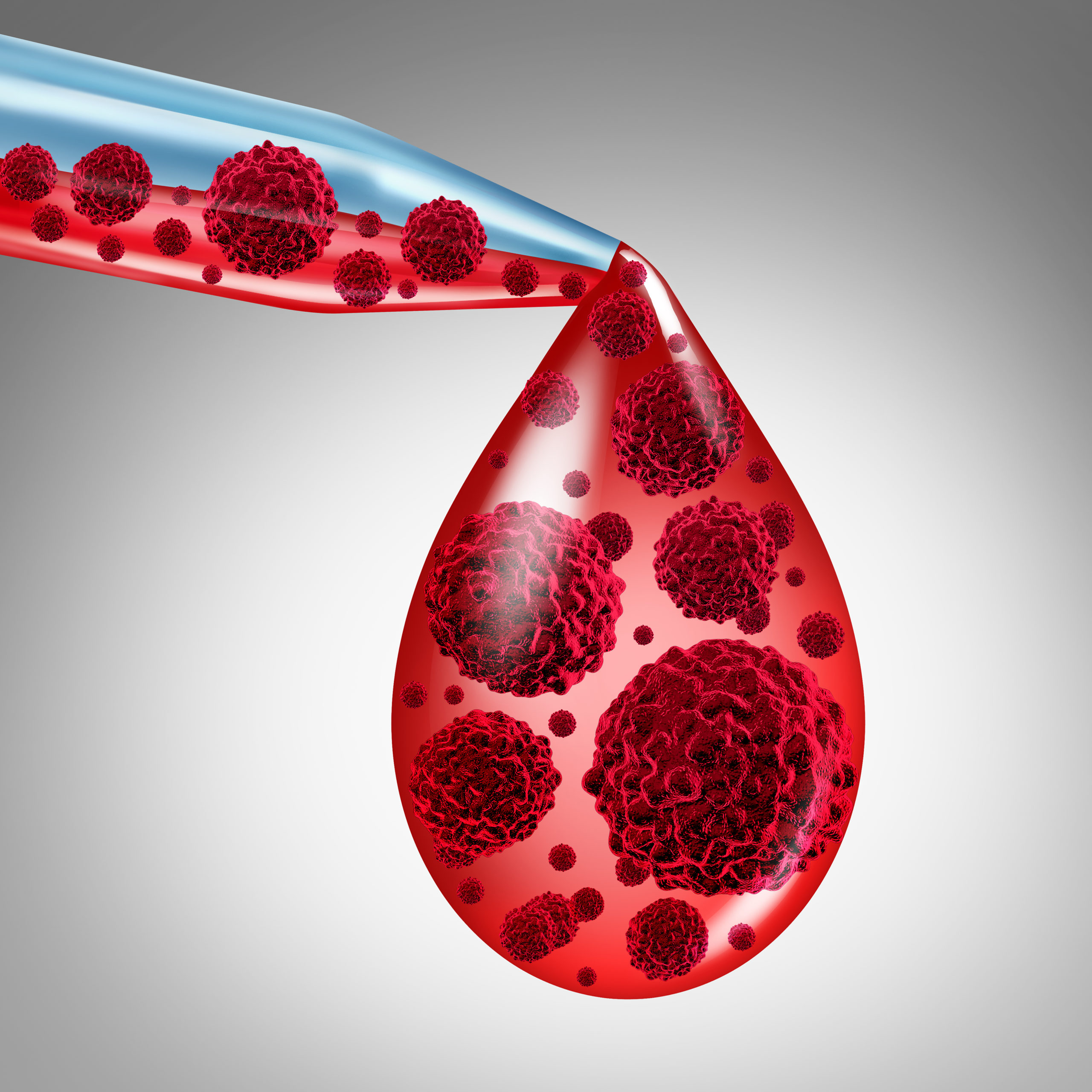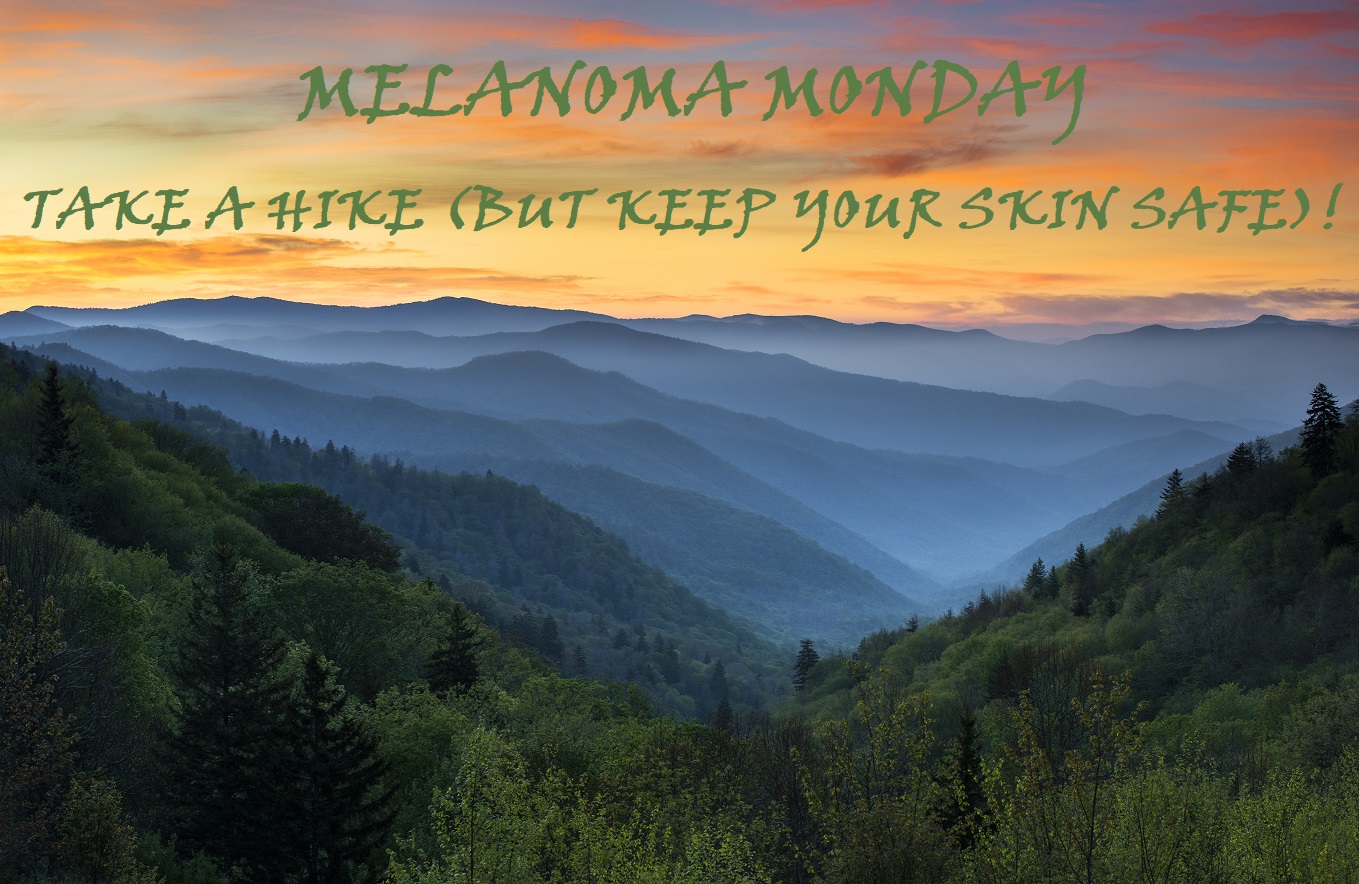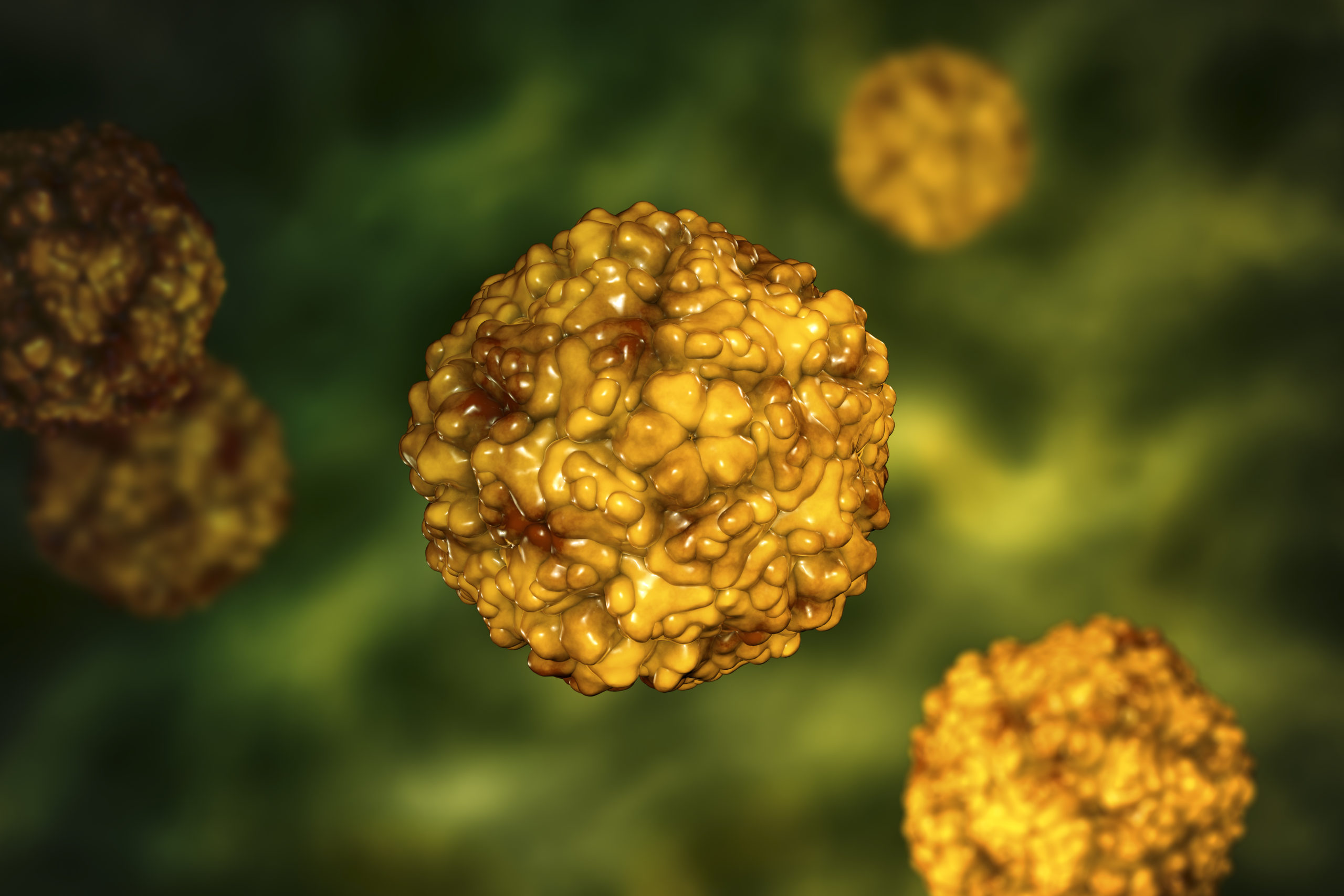NCMS, NCIOM Announce Report and Recommendations of the Carolinas Pandemic Preparedness Task Force
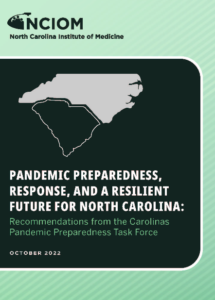
MORRISVILLE – The North Carolina Medical Society is pleased to join the North Carolina Institute of Medicine (NCIOM) in announcing the launch of the report and recommendations of the Carolinas Pandemic Preparedness Task Force, reflecting a vision for pandemic preparedness, response, and recovery in our state.
NCMS's Franklin Walker served on the NC work group, which was convened by the NCIOM in partnership with the South Carolina Institute of Medicine and Public Health between July 2021 and April 2022. Informed by insights and experiences from more than 90 experts and key informants, the North Carolina report of the task force elevates strategies to achieve equity, support data-driven decision-making and emergency management, and promote effective coordination in navigating public health emergencies.
Walker says “It was an honor to work with my colleagues from North and South Carolina to draft guidelines that should improve both states pandemic preparedness moving forward.”
The report identifies several areas of specific relevance to North Carolina:
- Access to the supplies necessary to effectively control the spread of disease, particularly among the most vulnerable (Chapter 3)
- Infrastructure changes to support adaptability (Chapter 4)
- Workforce development that prioritizes retention and strengthening the workforce pipeline (Chapter 5)
- Modernized surveillance and information systems to support data-driven decision-making and clear, effective, and tailored communication (Chapter 6)
- Expansion of broadband infrastructure and addressing digital literacy (Chapter 7)
- System changes to ensure supports and services can be accessed before, during, and after public health emergencies, and clear, effective, and tailored communications about the same (Chapters 8 and 9)
- Promotion of effective coordination and maximizing resources by establishing and maintaining partnerships (Chapter 10)
“This report should serve as a model for how leaders in health care, public health, and business and economic development in our state collaborate in future preparedness and response efforts,” said task force co-chair North Carolina Commerce Secretary Machelle Baker Sanders.
“While many of us, understandably, want to move forward and put the pandemic behind us, we know that it will take years to fully appreciate the implications of what we have been through,” said NCIOM President and CEO Kathleen Colville. “New insights and lessons will continue to emerge with time. We’re grateful to task force members for offering their experiences and perspectives while in the thick of pandemic response, and for their call on us as a state to invest in fundamentals like education, broadband, data systems, and relationships to prepare us for future emergencies.”
About the NCIOM
The North Carolina Institute of Medicine (NCIOM) is an independent organization focused on improving the health and well-being of North Carolinians by providing analysis on the health and well-being of North Carolinians, identifying solutions to the health issues facing our state, building consensus toward evidence-based solutions, and informing health policy at the state and local level. Learn more: https://nciom.org/about-us/
Facebook: https://www.facebook.com/ncinstituteofmedicine/
Twitter: https://twitter.com/NCIOM
LinkedIn: https://www.linkedin.com/company/north-carolina-institute-of-medicine
On Point: Colonoscopy Remains The Best Method To Prevent Colon Cancer - Several Doctors Respond to New Study
On Point submissions are individual member viewpoints and not North Carolina Medical Society policy.
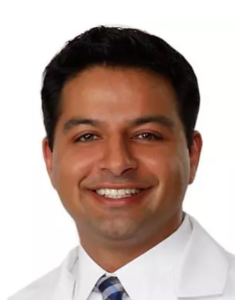
This blog post submitted by: Rajiv Majithia MD FACG AGAF1, Rig Patel MD2, Shifali Arora MD3, William Leland MD4, Andrew Muir MD5, Nicholas Shaheen MD MPH6
The recently published European study examining colonoscopy in Sweden, Poland, Norway, and the Netherlands, “Effect of Colonoscopy Screening on Risks of Colorectal Cancer and Related Death” in the New England Journal of Medicine calls into question the effectiveness of colonoscopy screening.[1] The findings of the Nordic-European Initiative on Colorectal Cancer (NordICC) trial by Dr Bretthauer, et al, casts doubt on the benefits of colonoscopy in preventing colorectal cancer (CRC), which is a leading cause of cancer deaths in the U.S. The results as presented, misrepresent the true impact of colonoscopy as a screening modality and could have a detrimental impact on colon cancer screening as a whole.
The NordICC study reported outcomes of patients in a randomized trial in which one third of patients appropriate for colorectal cancer screening were invited to undergo a one-time colonoscopy, while the other two thirds were randomized to usual care. The paper reports a primary intention-to-treat analysis, and demonstrates a modest decrease in colorectal cancer incidence (18% risk reduction) in those randomized to screening, as well as no statistically significant decrease in CRC mortality. The popular media has seized on these data to cast doubt on the value of colonoscopy in cancer prevention of CRC.[2]
Contrary to reporting, data from the trial strongly endorses the utility of colonoscopy as a preventive measure against colorectal cancer. The single most important and under-reported aspect of this trial is that only 42% of patients who were invited for a colonoscopy completed the procedure. Among patients who actually completed a colonoscopy, there was a strong protective effect against cancer, with a 31% decrease in colorectal cancer incidence as well as a 50% reduction in mortality compared to the population that did not complete a colonoscopy. These data are consistent with prior studies and reinforce that a colonoscopy is effective if it is completed. In prior studies, screening colonoscopy has been associated with a 40 to 69% decrease in the incidence of colorectal cancer. Additionally, studies have shown up to an 88% decrease in the risk of death from colorectal cancer.[3]
When evaluating the study and interpreting results, we must also take into account differences in the patient populations. Historic evidence demonstrates the incidence of colon cancer in Nordic countries is less than seen in the U.S. population. This data could certainly lead to a lower detection rate and thereby not be applicable to a U.S. population. In the NordICC group, the incidence reduction of colon cancer was three times higher in Norway than Poland, suggesting the groups were not equally matched in the arms of the trial.
Additionally, there is evidence that a substantial proportion of the colonoscopies done in this study were of sub-standard quality. A validated benchmark used to assess colonoscopy quality in the U.S. is the adenoma detection rate. Adenoma detection rate is the proportion of screening colonoscopies in which one or more adenomas is detected. Guidelines have suggested an adenoma detection rate of >25% by the endoscopist is the minimum acceptable to document quality of procedures.[4] In the NordICC study, nearly 30% of the endoscopists who were included in the study did not meet the adenoma threshold of 25% that is used as an established quality indicator for U.S. providers.
Finally, both the timeline of the benefit of colonoscopy, as well as its use as a serial exam are not adequately measured in this study. The benefits of removal of a polyp might not be evident in prevention of cancer death for a decade or more after the procedure. We often perform serial colonoscopies, not just one, when a patient has been demonstrated to be predisposed to polyp formation. Neither of these factors would be evident given the current trial’s design.
Occam’s razor is an often used problem solving technique in medical practice. The principle suggests that in a setting where competing theories or explanations exist, the simplest explanation is preferred and often valid. We should refer back to Occam to analyze the wide breadth of data that we have before us. The correct conclusion from the presented data is that colonoscopy reduces the incidence and the mortality of colorectal cancer. Do we have enough evidence to abandon colonoscopy for colon cancer prevention based on this trial? The answer is a strong no! While the NordICC trial findings raise interesting questions, unfortunately the study methodology and results leave much to be desired. The study certainly does not provide rationale for any patient to delay or forego colonoscopy for the screening of colon cancer.
The main take-home lesson from this study is that a screening test is unable to prevent cancer when it is not used. The tragedy of this trial was that 58% of those who were offered screening declined, condemning the trial to poor outcomes. As even the authors have noted, in this study with up to a 50% reduction in mortality risk, colonoscopy is a critical tool in preventing colon cancer. Here is the simple message that our society should continue to carry to our patients: screening colonoscopy prevents cancers and saves lives.
Author Information:
1 Medical Director, Division of Gastroenterology & Hepatology, UNC Rex Digestive Healthcare
2 Adjunct Professor, Department of Medicine, Chief of Division of Gastroenterology & Hepatology,
UNC Rex Digestive Healthcare
3 Assistant Professor, Vice Chief of Clinical Operations, Division of Gastroenterology & Hepatology,
University of North Carolina School of Medicine
4 President, North Carolina Society of Gastroenterology, Eastern Carolina University School of Medicine
5 Professor of Medicine, Chief, Division of Gastroenterology & Hepatology, Duke University
6 Bozymski-Heizer Distinguished Professor of Medicine, Chief, Division of Gastroenterology & Hepatology
University of North Carolina School of Medicine
[1]Bretthauer M, Løberg M, Wieszczy P, et al. Effect of Colonoscopy Screening on Risks of Colorectal Cancer and Related Death, New Engl J Med, 2022 Oct 9. doi:10.1056/NEJMoa2208375
[2]https://www.cnn.com/2022/10/10/health/colonoscopy-study-q-and-a-wellness/index.html
[3] Ladabaum U, Dominitz JA, Kahi C, Schoen RE. Strategies for colorectal cancer screening. Gastroenterology 2020;158:418-432.
[4] Rex DK, Schoenfeld PS, Cohen J, et al. Quality indicators for colonoscopy. Gastrointest Endosc 2015;81:31-53.
NCMS Responds to Durham Nurse Stabbed, Killed by Patient
RALEIGH -- June Onkundi was stabbed and killed by one of her patients while she was at work Tuesday.
Onkundi was a mother of four who worked as a psychiatric nurse practitioner at Freedom House Recovery Center in Durham.
NCMS CEO Chip Baggett released the following statement on her death:
The North Carolina Medical Society joins people from around the state in mourning the tragic death of June Onkundi. Our thoughts are with her family and friends as they face life without her. June was working as a nurse practitioner when her own patient stabbed and killed her.
Her death is a reminder of the violence in the workplace that health care workers face very day. The NCMS continues to be a resource for medical professionals and strongly supports efforts to keep the workplace safe.
June’s death shines a light on the threat our members face every day. We wish the very best for her loved ones.
On Point: Bone Health is a Women's Healthcare Issue - by Dr. Andrew Bush
On Point submissions are individual member viewpoints and not North Carolina Medical Society policy.

Dr. Andrew Bush, MD, FAAOS, FACS, CWSP
Rates of osteoporosis and fractures associated with poor bone quality, which are known as fragility fractures, are at epidemic levels. It is estimated that osteoporosis affects approximately 200 million people world-wide. Currently, it is also estimated that 10 million individuals over age 50 in the United States have osteoporosis. Each year an approximately 2 million individuals suffer a fracture due to osteoporosis. The risk of a fracture increases with age and is greatest in women. Approximately 1 in 2 women and 1 in 5 men age 50 or older will experience a hip, spine, or wrist fracture sometime during their lives. Approximately 40% of individuals are unable to return to their homes following a fragility fracture and require relocation to a nursing facility. As many as 20% of individuals will die within 6 - 12 months of a fragility fracture. Also, an additional 33.6 million individuals over age 50 have low bone density or “osteopenia” and thus are at risk of osteoporosis and fragility fracture. Estimated costs of providing care for osteoporotic fractures among Medicare beneficiaries was approximately $14 billion in 2018. The cost is expected to increase to over $23 billion in 2025.
To stem the exponential rise in osteoporosis and fragility fractures and the associated human suffering and financial burden on society, it is important that our healthcare policy makers develop and implement public-wide screening and testing programs, and education programs to increase awareness of the public on the importance of bone health. Also, our leadership needs to show that it is serious in this endeavor by allocating sufficient resources to the front-line healthcare providers to appropriately address this crisis in their patient base. However, until that policy-shift happens, there are things that can be done on an individual basis to maximize bone health and to minimize the risk of fracture.
Bone health is not too different from heart health or gut health – we have to realize that all of our body systems work together in unison and often it is when that synergy gets interrupted and things are out-of-synch that we get sick. The basics of good health are pretty consistent – nutritious and balanced diet, active lifestyle, minimizing stress, appropriate exercise and plenty of rest. Also avoiding unhealthy lifestyle habits such as smoking and excessive alcohol consumption and eating low-nutrition and overly processed foods. These recommendations are pretty universal. However, there are some bone-specific recommendations.
Proper nutrition is extremely important for healthy bones throughout life but in particular during the years that bone is forming – up to approximately 30 years old. After that, the amount of bone that we have in our bodies will decrease as we get older. This bone loss happens in both men and women but it happens at much more rapidly and to a higher degree in women. There are some estimates that women may lose approximately 20-30% of their entire bone mass in the 10-15 years surrounding menopause. That is why the majority of fragility fractures happen in women. Now it is not inevitable that all that bone loss has to happen and things can be done to prevent or slow down bone loss. Although the main goal of a Bone Health program is to stop bone loss, it is just as important to address bone health early - early implementation of health nutritional habits twill help maximize the bone-building process and will optimize the amount of bone that we have throughout our lives.
An additional factor that is very important in both forming and maintaining healthy bone is activity and exercise. Bone development and remodeling is driven by the applied forces that the bone “feels”. Impact (light to medium) stimulates the bone cells called osteocytes that live in the bone matrix to send out signals to the bone building cells – the osteoblasts to start responding to those forces by building more bone. Also, bone health is maintained when muscles are strong so that the bone “feels” the pull of those muscles. Strong muscles come from living an active lifestyle and doing regular exercises. There is a theory that optimal bone building comes from additional exercises – the phrase “osteogenic loading” specifically refers to exercises where bone feel additional applied forces that stimulate bone to maintain its optimal composition. It is also known, that maintaining muscle strength helps maintain a good sense of balance – and when you have good sense of balance falls and therefore breaks are less likely!
Monitoring of the bone health is the foundation of fracture prevention in the way monitoring blood pressure is to stroke prevention and mammograms are to breast cancer prevention. The early detection of any of these conditions, allows for early treatment to be institutes to prevent the long-term consequences of the disease. Bone health assessment is looking for osteoporosis. Although, some may still consider developing osteoporosis an unfortunate part of growing older, it is now understood that fracturing due to idiopathic age-related bone loss is not an inevitable part of aging but a potentially preventable disease process. Nutrition and exercise fight against osteoporosis – monitoring makes sure that they are working.
The term for bone monitoring is known as bone densitometry – the measurement of bone density. Determining bone mineral density (BMD) has been the traditional method of diagnosing osteoporosis and predicting fracture risk. The most common way to measure BMD is by using Dual Energy X-ray Absorptiometry (DXA). DXA has been around for over 30 years and has been the backbone of Bone Healthcare. It is a method of measuring BMD by using low-energy x-ray and has been considered reasonably reliable for measuring BMD and diagnosing and treating osteoporosis.
There is another method of bone densitometry that not only determines BMD but also give a measure of the Bone Quality. Radiofrequency Echographic Multi Spectrometry (REMS) is a newer method of performing monitoring bone health that was developed and has been used in Europe for almost ten years and has replaced DXA as the official method of bone densitometry in Italy. REMS uses ultrasound to measure BMD. However, the ultrasound is also capable of measuring Bone Quality and therefore when REMS is used to assess bone, more information is obtained and there is a better way to predict fracture risk. REMS is still very new in the United States but its popularity is growing as more and more people are finding out about it.
If levels of nutrition and exercise were not enough to maintain a healthy skeleton, or other medical conditions are affecting bone quality, then there are specific medications that can help to prevent bone loss or even to reinvigorate the bone to build back a little. The decision to use any of these medications should be made in consultation with your bone healthcare provider. And if you are started on any of these medications you must be compliant with the directions of use and monitoring the effectiveness of the medications is also essential.
In conclusion, it is important to remember that your bones need to be monitored and cared for like any other part of you and although we focused on bone health as a women’s health issue, poor bone health can affect anyone. So, bone healthcare is an issue for everyone and something that we all need to be aware of. Everyone has a skeleton and we need to pay attention to and take care of our skeletons because ...
If you ignore your bones, they will go away!
Dr. Bush is with Central Carolina Orthopedic Associates.
Goodbye Social Distancing! So Long Masks! Hello Again to Viruses?

After several years of focusing on COVID-19, several other viruses are making a comeback. A surge in illness in North Carolina is being caused by different viruses, including rhinoviruses, enteroviruses, RSV, and influenza.
State Epidemiologist Zack Moore says, "A couple of months ago, if someone had a cold, I'd tell them, 'That's COVID.' That's not the case anymore. It's much more of a mixed bag."
An article in NC Health News says that the spike in respiratory illnesses is happening especially in children. Emergency Room visits are on the rise. StarMed, with clinics across the state are seeing spikes in patients testing positive for influenza and an administrator from Appalachian State University says significant numbers of people are testing positive for influenza A.
To some, these are another consequence of the pandemic. Many of these viruses were a non-issue while the country was wearing masks and social distancing. Now they are back.
Michelle Crouch and Charlotte Ledger tell the story of a mother with an infant in distress and have more on what's happening across the state in their latest article. To read more click here.
LEAD Keynote Talk: LTG (Ret) Rick Lynch on 21st Century Leadership
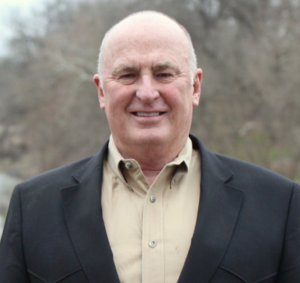
RALEIGH — The 2022 North Carolina Medical Society LEAD Health Care Conference is underway! Medical professionals from across the state are in Raleigh for dynamic speakers, MEDTalks, and learning opportunities.
On Friday, the keynote speaker is LTG (Ret) Rick Lynch. He is talking his extensive military career, including several tours in the Middle East. His focus is adaptive leadership for the 21st century.
Here is a preview of his presentation.
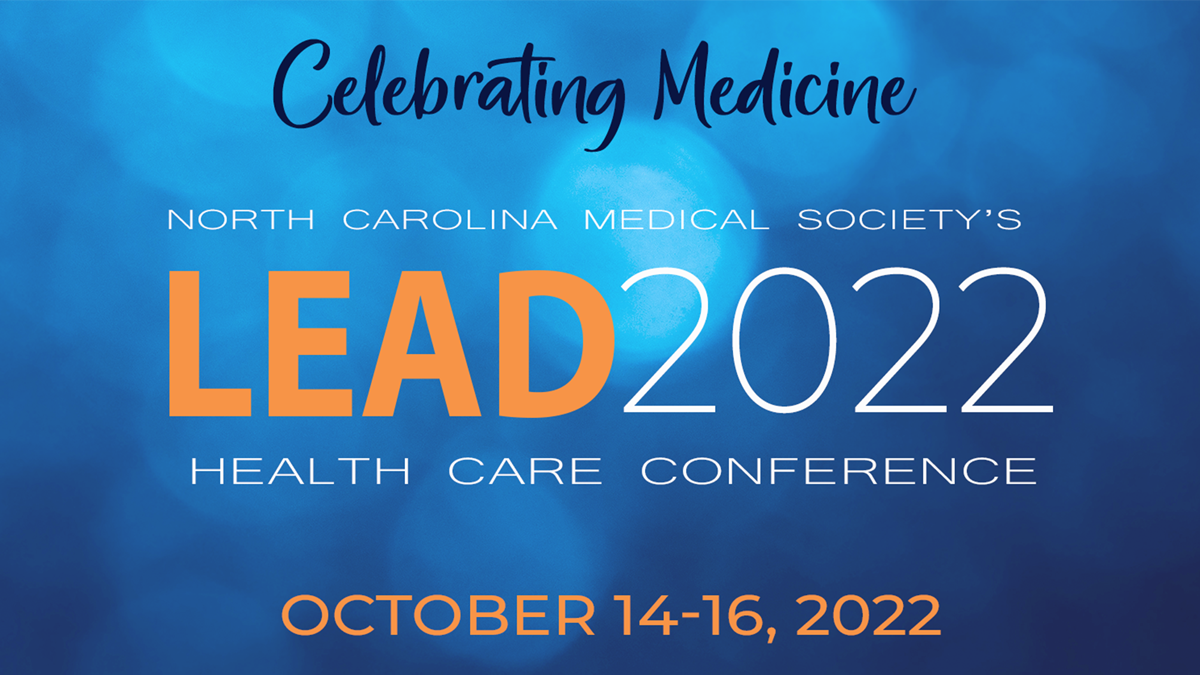
DHHS System Update, Outages include Epi-on-Call and State Lab Online Portal

New UPDATE on DHHS IT Outage:
The system outages also include Epi on Call and the State Lab's Clinical and Environmental Lab Results (CELR) online portal.
During this time, Epi On Call and other urgent communicable disease issues can be directed to 919-218-9778 which will be staffed 24/7. The State Laboratory of Public Health continues to accept and test clinical specimens and environmental samples. Test results will be reported using paper only. Test results for critical specimens can also be obtained by calling 919-733-3937
URGENT! Update on DHHS IT System Outages

DHHS IT system outages are expected to continue today. Please work with your patients to continue to provide care as best as possible. In addition, as part of the system outages, some WIC families may not be able to access their benefits immediately. NCDHHS wants to ensure that these families are supported as much as possible, especially for those who may need infant formula immediately or urgently today or this weekend. Please consider reaching out to families that are reliant on WIC benefits, particularly infants who rely on formula as their sole source of nutrition. If your office can assist with samples or other resources, that would be appreciated. You can also connect those families with their local WIC agency for additional support.
More info is available by clicking here.
Dr. John Barkley is 2022 Harris Memorial Award Winner

RALEIGH -- Congratulations to John Barkley, MD, for winning the 2022 Carolinas Center for Medical Excellence's Harris Memorial Award
Dr. Barkley is a committed community leader and mentor. He has a long list of achievements in healthcare and service to the medical community. Included in his accomplishments are his work to drive better outcomes for patients and caregivers, the creation of the SNF Preferred Network, the Sentinel Task Force for post-acute care service lines, and numerous boards, teams, and awards.
He joins Miriam Schwarz as the John Huske Anderson Award winner and Dr. Robert E. Schaaf, MD, FACR, for winning the 2022 E. Harvey Estes, Jr. Physician Community Service Award. Our Golden Stethoscope Award winners are Dr. Kerianne Crockett, Dr. Rebecca Hayes, Dr. Suneya Hogarty, and Dr. Lisa Kaufmann.
He will be given his award at the 2022 Golden Stethoscope Awards Gala on Saturday night at the Raleigh Marriott Crabtree.
Miriam Schwarz is the 2022 John Huske Anderson Award Winner

RALEIGH -- Congratulations are in order for Miram Schwarz, the 2022 John Huske Anderson Award winner.
Schwarz is known around the state as a tireless champion of the underdog. Under her leadership, the Western Carolina Medical Society has successfully become a beacon for people who need help. Among her accomplishments are Project Access, the WNC Colorectal Cancer Screening Initiative, and the WCMS Interpreter Network. She has been described as having a brand of fierce kindness that is needed in the world today and as someone who has taken the art of advocating and made it beautiful.
She joins Dr. John Barkley as the Harris Memorial Award winner and Robert E. Schaaf, MD, FACR as the E. Harvey Estes, Jr., MD, Physician Community Service Award. Our Golden Stethoscope Award winners are Dr. Kerianne Crockett, Dr. Rebecca Hayes, Dr. Suneya Hogarty, and Dr. Lisa Kaufmann.
She will be given her award at the 2022 Golden Stethoscope Awards Gala on Saturday night at the Raleigh Marriott Crabtree.
Dr. Robert E. Schaaf is the 2022 E. Harvey Estes Physician Community Service Award Winner
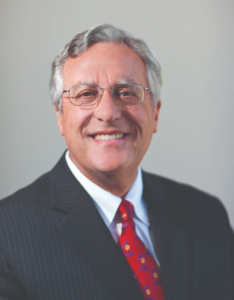
RALEIGH -- Congratulations to Robert E. Schaaf, MD, FACR, for winning the 2022 E. Harvey Estes, Jr., MD, Physician Community Service Award.
Dr. Schaaf has been serving people in the Triangle area of North Carolina for nearly five decades. He is known for his deep belief that all North Carolinians deserve safe, high-quality care. His commitment to the community has spanned work with the American Red Cross, NCMS, various statewide boards, Wake Forest University, and he has been on the NC Medical Care Commission for four North Carolina governors.
He joins Miriam Schwarz as the John Huske Anderson Award winner and Dr. John Barkley as the Harris Memorial Award winner. Our Golden Stethoscope Award winners are Dr. Kerianne Crockett, Dr. Rebecca Hayes, Dr. Suneya Hogarty, and Dr. Lisa Kaufmann.
He will be given his award at the 2022 Golden Stethoscope Awards Gala on Saturday night at the Raleigh Marriott Crabtree.
We Are the North Carolina Medical Society
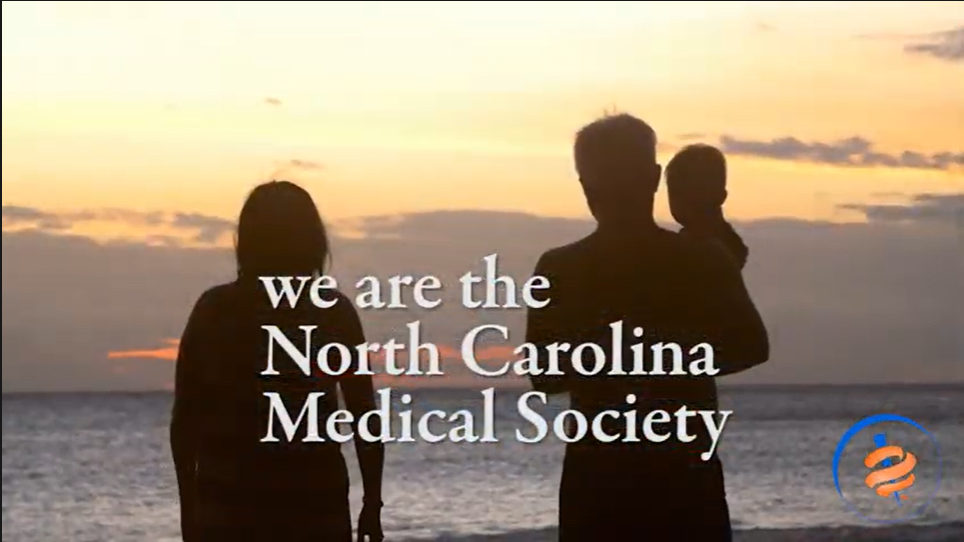
The NCMS premiere event of the year is back! The annual LEAD Conference and our first Golden Stethoscope Awards Gala is this weekend.
In advance, here is a look at what NCMS is doing for its members and the people of North Carolina.
Enjoy!
Are You Sad This Time of Year? Ways to Beat Seasonal Affective Disorder
- When a person struggles emotionally and has low energy during the year’s darkest months, they may have seasonal affective disorder (SAD) or seasonal depression.
- Due to the COVID-19 pandemic, health experts say this condition can make things even more difficult.
- Exposure to specific types of bright light is the most clinically supported solution for seasonal affective disorder.
- Medical News Today spoke with three medical experts to offer insights on how to spot the symptoms of seasonal depression and better manage the disorder this fall and winter.
During the dark autumn and winter months, when days become shorter, many people experience seasonal affective disorder (SAD, or seasonal depression, especially those living in countries farther from the equator. It is a type of depression in which one’s mood and energy levels may fall based on recurring seasonal patterns, affecting one’s feelings and behavior.
Experts say SAD may be especially challenging this year for people still experiencing the lingering psychological effects of the COVID-19 pandemic.
Medical News Today asked three experts to provide insights into this often-debilitating condition.
Our experts are:
- Associate Professor of Psychiatry Dr. Paul Desan, Ph.D. of the Winter Depression Research Clinic at Yale Medicine, New Haven, CT
- Dr. Sandra J. Rosenthal, Ph.D., professor of chemistry, pharmacology, and chemical and biomolecular engineering at Vanderbilt Institute of Nanoscale Science and Engineering in Nashville, TN
- Psychotherapist Dr. Mayra Mendez,Ph.D. at the California Graduate Institute in Los Angeles, CA
Symptoms of seasonal affective disorder
Dr. Desan: “Seasonal affective disorderTrusted Source of the winter type starts in the fall, gets worse through the winter, and gets better in the spring. And if that happens most years as a recurring pattern, someone has seasonal affective disorder.”
Dr. Rosenthal: “At first, it would just look like depression, which could include loss of interest in activities, decreased energy, constant rumination, catastrophizing, and feelings of hopelessness.”
Dr. Mendez: “Some common symptoms include feeling tired and sad most of the day for a period of two or more weeks, having a low energy level and procrastinating or putting off doing necessary tasks or responsibilities, increased appetite and possible weight gain, tendency to isolation and avoid social contacts, and a tendency for oversleeping.”
Dr. Desan: “Technically, to have seasonal affective disorder as a diagnosis, you have to meet [the] criteria for major depression as defined by psychiatrists in the U.S.
There is a somewhat larger group of people who find that their mood, energy, sleep, or their appetite is altered in the winter enough that they seek help, and they may not actually meet the criteria for major depression. We call that ‘subsyndromal seasonal affective disorder,’ but we see plenty of people in our clinic that come in and just don’t have good energy in the winter.”
What causes SAD or seasonal depression?
Dr. Mendez: “Research indicates that seasonal affective low mood may be informed by some people’s response to a decrease in daylight hours. It is less common, although not impossible, for affective seasonal patterns of depression to occur in the summertime.”
Dr. Rosenthal: “Solar insolation is the amount of sunlight one experiences at their location on the surface of the [Earth]. The rate of change of solar insolation triggers changes in SAD.
It is more complicated than you think. Cities at the same latitude can have very different rates of change of solar insolation due to climate, so onset and abatement of symptoms [depend] very much on where you live.”
Dr. Desan: “We know that in lots of mammalian species when you expose the organism to all kinds of winter light, physiology and winter-type behavior start happening. Even though we live in artificial environments, most human brains seem to be aware of the length of the light-dark cycle, and we know that the chemistry in people’s [brains] changes from various kinds of studies across the year.
Now, which chemical in what place is actually linked to human mode? That is not known.
It’s quite likely that it isn’t just simply [chemical] levels because a lot of research has not supported the idea that it’s just simply the amount of serotonin or anything else.
I feel it probably has something to do with turnover and circuit properties. To think that you just have a certain level of some chemical in your brain that goes up and down? We know it’s not that simple.”
SAD and COVID-19 pandemic
Dr. Rosenthal: “The country has seen a spike in anxiety and depression from COVID. When you throw in an underlying condition of SAD, the two effects amplify each other.”
Dr. Mendez: “Individuals diagnosed with mental health conditions, particularly bipolar or depressive disorder, are at greater risk of experiencing seasonal affective disruptions.”
Dr. Desan: “We’re seeing across all of our patient mental health clinics an increase in distress and number of visits.”
Dr. Desan said lifestyle changes brought on by COVID-19 might also be a factor.
“The other thing that we’re noticing is when people are home a lot, they don’t get up in the morning and get exposed to bright light. Consequently, I think seasonal factors are stronger,” he said.
How to prevent SAD or manage symptoms?
Dr. Desan: “Exposure to bright light first thing in the morning is well-validated by multiple research studies because the time that the sun comes out is the most important circadian signal in lots of species.
If you fool the brain into thinking that it’s a bright day early in the morning instead of thinking it’s winter, the brain thinks it’s summer.”
His team has compiled a comprehensive list of specific light boxes that may help combat SAD. They update the list regularly.
Dr. Rosenthal: “Starting August 15, and ending January 15, use the light box for 30 minutes a day. A common recommendation is to use it at noon.” She also noted that many individuals with SAD use antidepressants.
Dr. Rosenthal also offered some perhaps less orthodox ideas:
- When feeling down, consider doing a less overwhelming task that may help boost your mood.
- Spend time playing or talking with your furry friends. If you do not have a pet, consider visiting or volunteering at your local animal shelter or just cuddling with a stuffed animal or furry blanket for a few moments.
- Create special memories, practices, traditions, and rituals. Dr. Rosenthal said this helps you step out of the melodrama and provides an opportunity for interaction that you might otherwise neglect or avoid.
- Embrace making simple and easy-to-manage life changes. For example, change the furniture in the home. This strategy activates creative juices and increases the chances of a greater sense of purpose and value in life through small changes.
- Practice mindfulness, and do not neglect the activities that typically bring you joy, such as gardening, exercising, biking, hiking, and any civic affairs, forums, and programs that may interest you.
- Volunteer time for a cause. These activities help to reduce isolation, increase engagement in purposeful and meaningful activities, and provide the opportunity to positively impact others’ lives.
- Wear your favorite outfit. Dr. Rosenthal said this simple act might lift your spirits and self-esteem.
Michelle Laws and Kristina Natt och Dag Are Ready to See You at LEAD and Our Gala This Weekend
RALEIGH — Chief Experience Officer Michelle Laws and Vice President of Education and Training Kristina Natt och Dag are fired up and ready to see you Friday and Saturday for the annual LEAD Conference and the 2022 Golden Stethoscope Awards Gala.
Both of them have a message for you about how great it is going to be and how much fun you’ll have!
Take a listen!
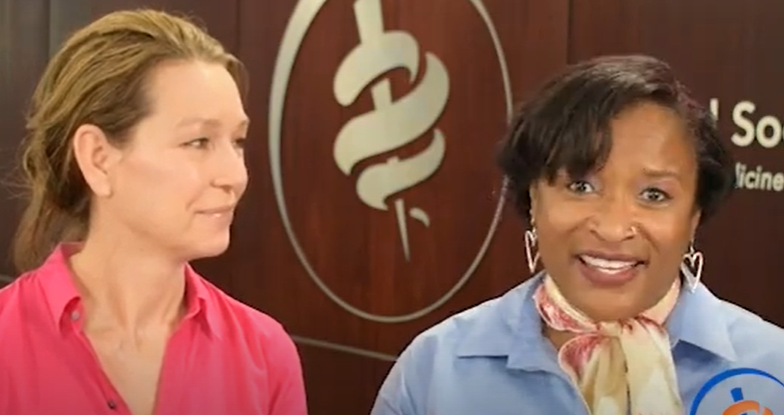
A New Restaurant Has Gone to the Dogs

SAN FRANCISCO -- A new fine-dining restaurant in the Bay Area has gone to the dogs, literally.
The Los Angeles Times reports that the new restaurant Dogue only serves canines.
Owner and head chef Rahmi Massarweh said Dogue may be the first restaurant in the country to serve a tasting menu exclusively for dogs. It offers meticulously crafted pastries from its in-house “pawtisserie” and French-inspired courses made with locally sourced, organic ingredients.
If you really want to treat Fido, Dogue serves Parisian pastries and “dogguccinos” that start at $4.95. When you really want to spoil your best friend, Dogue has a $75 three-course meal — which is seasonal and rotates frequently. Pet owners can choose from a variety of dishes, such as organic beef chuck steak with fermented carrots and beets or green-lipped mussels with fermented carrots and wheatgrass.
If you are ready to take your dog to chow down, read more here.
Monday Nights Getting A Bit Safer
 (CNN) -- The National Football League and the NFL Players Association agreed to update the league's concussion protocol over the weekend.
(CNN) -- The National Football League and the NFL Players Association agreed to update the league's concussion protocol over the weekend.
The decision follows a review of the response to Miami Dolphins quarterback Tua Tagovailoa's injury on September 25 after he suffered an apparent head injury and was later allowed to reenter the game. He was later hospitalized for a concussion. Under the new protocols, players will be unable to compete if they are experiencing ataxia, which describes a lack of coordination caused by poor muscle control. The NFL's chief medical officer said the NFL would take a "conservative" approach to ruling players out. On Sunday, the new concussion protocol went into effect and several players were sidelined under the new rules.
No One Fights Alone! NCMS Staff Show Support for Breast Cancer Awareness Month
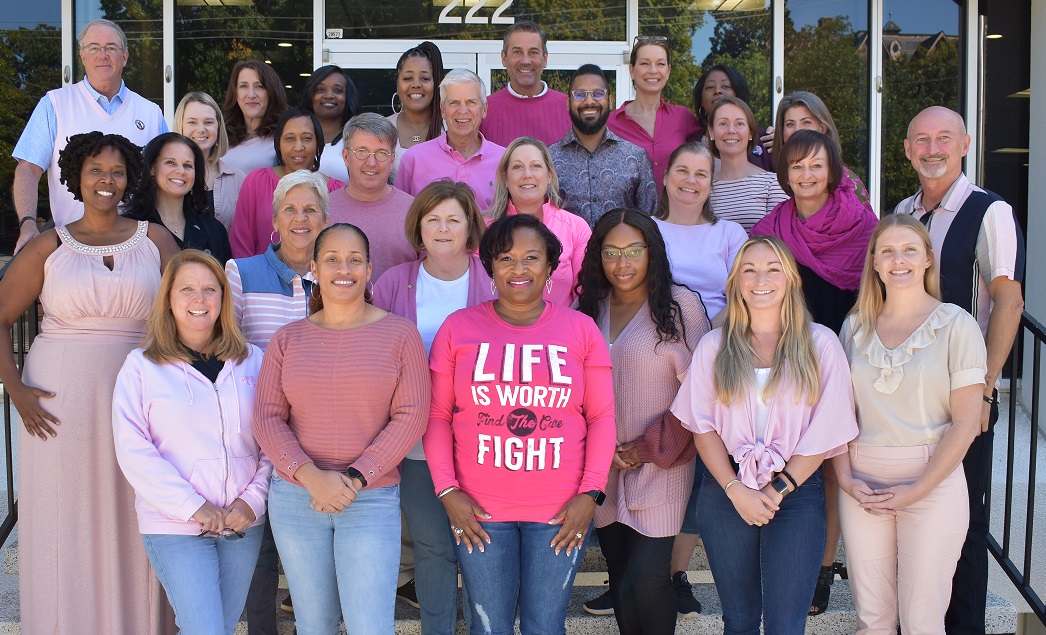
RALEIGH — The staff of the North Carolina Medical Society are wearing pink to support National Breast Cancer Awareness Month. As a team we support breast cancer patients, survivors, and the friends, family, and health care providers.
October is National Breast Cancer Awareness Month, an annual campaign to raise awareness about the impact of breast cancer. This year we RISE to ensure every woman has access to the screenings she needs and the support she deserves. When we RISE, we Rally in Screening Everyone.
The American Cancer Society says breast cancer death rates declined 40% from 1989 to 2016 among women. The progress is attributed to improvements in early detection.
Here at the North Carolina Medical Society we support efforts to improve early detection and treatment programs. The National Breast Cancer Foundation has many resources for patients, family, and the community to get involved in helping others. Please visit their Breast Cancer Awareness Month page by clicking here.
Are Airplanes A Public Health Risk? EPA Says Yes

(REUTERS) -- The Environmental Protection (EPA) said on Friday that it is proposing to declare emissions from piston-engine aircraft operating on leaded fuel pose a danger to public health.
The concern is emissions from nearly 200,000 U.S. general aviation airplanes. Lead is not in jet fuel, which is used by commercial aircraft.
Airborne lead in the United States have declined by 99 percent since 1980, however piston-engine aircraft are the largest remaining source of lead emissions into the air.
Children's exposure to lead can cause irreversible and lifelong health effects.
The EPA said if the proposed "endangerment finding" is finalized, it would subsequently propose regulatory standards for lead emissions from aircraft engines.
The full story is available by clicking here.
Cheers! to these 2022 Golden Stethoscope Awards Gala Table Sponsors

It is almost time to put on your best outfit and celebrate medicine! The 2022 NCMS Golden Stethoscope Awards Gala is approaching quickly. We want to thank our table sponsors:
- Appalachian Regional Health System
- Clinton Medical Clinic
- Carolinas Center for Medical Excellence
- North Carolina Medical Society Alliance
- Old North State Medical Society
- Raleigh Neurology Associates
- Robeson Pediatrics
- Wake County Medical Society
- Wake Radiology
We will see you all on October 15th at the Raleigh Marriott Crabtree. Don't forget there is a special champagne event with a chance to win a diamond ring!
To get tickets click here.
Bubbles and Bling Bring Sparkle to the 2022 Golden Stethoscope Awards Gala!

What is a gala without a bit of bling?
This beautiful ring could be yours at the 2022 NCMS Golden Stethoscope Awards Gala October 15!
Our Bubbles and Bling Raffle brings together champagne and carats! Each glass of champagne purchased enters you into a raffle to win this ring. Proceeds go to the NCMS Foundation to help people
From the Forevermark Tribute Collection, this stunning 18k yellow gold ring features an array of bezel set round cut diamonds along the band. It is almost a full carat of diamonds! It is courtesy of Reeds Jewelers Crabtree.
The Forevermark Tribute Collection celebrates the unique and brilliant woman who wears it. The pieces can be worn stacked or layered to reflect your individual style and character. When combined, the look features multiple diamonds, paying tribute to the many qualities that together make you the incredible woman that you are.
The Forevermark Promise:
- Beautiful: Forevermark diamonds are genuine, untreated, and natural.
- Rare: Less than 1% of diamonds qualify to be a Forevermark diamond.
- Responsibly sourced: Each Forevermark diamond has met high standards of business, social, and environmental integrity at every step of its journey.
- The inscription: Each Forevermark diamond has the Forevermark icon and a unique identification number on the table of the diamond visible only under a Forevermark viewer.
Tickets are going fast! Make sure to join your friends and colleagues October 15 at the Marriott Raleigh Crabtree.
Winter, Vaccines, Billions of Dollars, and Lives Saved. What Doctors Need to Know Before Temperatures Drop
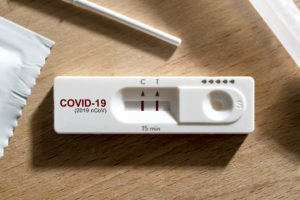
A new report on Fall COVID-19 booster shots says thousands of lives will be saved this winter. With that, billions of dollars will also be saved by the American public. The catch? It will only happen if people get the booster. Without the extra shot, the nation could see 1,000 COVID-19 deaths per day this winter.
The Commonwealth Fund published a report Wednesday, stating there are now about 400 COVID-19 deaths per day in the United States. Researchers found that if the uptake of Covid-19 boosters this fall is similar to the uptake of 2020-21 flu vaccinations, it would prevent more than 75,000 deaths and more than 745,000 hospitalizations and generate medical cost savings of $44 billion by the end of March, compared with the baseline scenario.
If boosters stay at their current pace, America could see a winter surge in cases and deaths, further burdening hospitals.
The full report is available here.
Yom Kippur begins Tuesday Evening
On behalf of the staff at the North Carolina Medical Society, G’mar Chatimah Tovah.

ATTENTION MEDICAID PROVIDERS: Nearly 300 Physicians Suspended Over Expired Credentials

RALEIGH -- In May of 2021, NC Medicaid started taking additional steps, as outlined in the NCTracks Changes to Provider Verification Process bulletin, to ensure providers meet contractual obligations to maintain their credentials on their enrollment record. Multiple bulletin articles were published to notify providers of the change, and providers receive four targeted reminders prior to their suspension notifications.
On August 31, 2022, approximately 279 Allopathic and Osteopathic Physicians were suspended due to an expired credential. These providers have sixty days from the date of suspension to ensure that their license is renewed, and their NCTracks provider enrollment record is updated to avoid termination.
Providers may update their NCTracks provider record through the Manage Change Request process. NCTracks User Guides and Fact Sheets offer basic instructions for making the necessary update and any additional questions may be referred to the NCTracks Call Center at 800-668-6696.
NCTracks Changes to Provider Verification Process bulletin: https://medicaid.ncdhhs.gov/blog/2021/04/14/nctracks-changes-provider-verification-process
NCTracks User Guides and Fact Sheets: https://www.nctracks.nc.gov/content/public/providers/provider-user-guides-and-training/fact-sheets.html
¿Doctor, Habla Español? Here Is Some Ayuda

As we continue to celebrate Hispanic Heritage Month, the North Carolina Medical Society is looking to make it easier for you to communicate with your Spanish speaking patients.
Here is the new NCMS English to Spanish guide. We will have laminated cards that easily fit into your pocket at the 2022 LEAD conference. Until then please feel free to download this simple-to-use form.
Click here for the form.

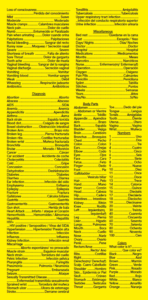
Oh My Gourd! Cooking With Squash is All The Rage This Fall!

Celebrity chef Andrew Zimmer is saying 'Oh My Gourd' to a whole new world of cooking!
Harvested in the fall, gourds will last throughout the cold winter months, hence the name winter squash. Squash come in a staggering diversity of size, shape and color. With generally mild and sweet flavors, squash are easy to incorporate into your meal, they absorb seasonings well and are great in soups, pies, risotto, casseroles and even breads.
The attached article is full of information for you, your family, and your patients. Don't miss the delicious recipes at the end of the article.
Click here for all you need to know.
North Carolina Medical Society Alliance Celebrates Centennial - Part 3
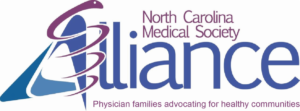
RALEIGH -- Next year the North Carolina Medical Society Alliance celebrates 100 years! The Alliance works to improve the health of all people in North Carolina.
In advance of the anniversary, NCMS Alliance is sharing some history and stories of it’s history. Here is the second in a series.
Reviewing the 1940s...
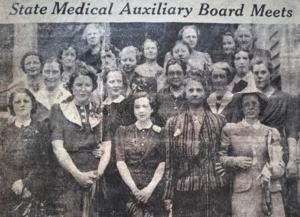
On Monday Afternoon, April 15, 1940 the State Medical Auxiliary Board Meets
The North Carolina Medical Society Auxiliary in the 1940s
The Auxiliary to the Medical Society of North Carolina began the decade by expanding its sanitorium bed project to the Western Sanitorium in Asheville, later naming that bed for Dr. Martin Stevens. Soon, the developments of World War II influenced members’ efforts. In 1941, a National Defense Chairman led the Auxiliary in a project to collect surgical instruments and medical supplies called Aid to Britain. In 1942, members funded the USS Fremont battle dressing station and sold Mercy Emblems for emergency medical field kits. By 1943, Auxiliaries were directing much of their energy to the war effort, meeting troop trains with doughnuts and coffee, knitting and sewing, using their endowments to purchase war bonds, and raising money for the Medical and Surgical Relief Committee. In 1944, 210 members gave 113, 355 hours to war service committees!
The Auxiliary continued other projects during the war. In 1944 the group established the Cooper Bed, named for George Martin Cooper, MD, in the Eastern Sanitorium in Wilson. During the poliomyelitis epidemic in that same year, members assisted clinics and physicians to get through the crisis, which hit some areas of the state very hard, and assisted in the gamma globulin and Salk mass vaccine clinics. Members also volunteered in hospitals by staffing canteens, creating library services for patients, contributing linens, and furnishing rooms in hospitals and nurses’ homes.
A shortage of graduate nurses followed the war. So, in 1948 the Auxiliary started Future Nurses Clubs which involved hosting teas, giving hospital tours and other activities to generate interest in nursing among high school students. The Auxiliary provided loans and scholarships for qualified students to study nursing.
By 1949, when the annual meeting was held in Pinehurst, membership in the Auxiliary to the Medical Society of North Carolina had grown to 1321 members. Forty-three local auxiliaries existed with 10 of those reorganizing during the 1940s. Yearly dues increased to $2.00 in 1948 with $1.00 going to national dues. Half of the state dues, or fifty cents, went to various Memorial Bed funds in state sanitoria. Other highlights of the 1940s include--
1940: The Auxiliary supported a legislative bill requiring a medical exam for a marriage license and a Wassermann test for pregnant women.
1941: Auxiliary members compiled a mailing list of physicians’ wives. The work of the Auxiliary was divided among eleven committees. Chairmen of these committees kept notebooks of their projects that were passed on to their successors.
1942: The Board of Directors met only twice a year instead of four times.
1945: Members continued to be active in the war effort. The annual meeting was canceled to conserve gas and oil. The Auxiliary president traveled by public bus.
1946: The State Auxiliary received a Treasury Award for Patriotic Service. Members made surgical dressings for cancer patients and kept up with medical legislation.
1947: Members adopted the motto, Service to Others. Frederick Taylor, MD of High Point designed the first state seal.
1949: The Public Relations Committee began its work. Members staged a write-in to legislators to help defeat national compulsory health insurance.

Mrs. Sidney Smith (Melissa) President: 1941-42

Mrs. C. F. Strosnider (Anna), President 1939-1940
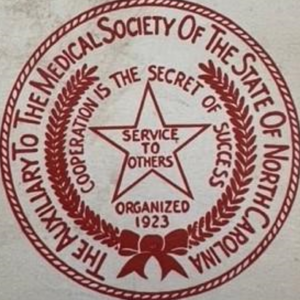
The 1st State Seal
For more information on the North Carolina Medical Society Alliance or to join click here.
Ian reforms as Category 1 hurricane, takes aim at Carolinas

RALEIGH -- Hurricane Ian cut a swath across Florida as a category 4 hurricane and nearly a category 5. As it crossed Florida is slowed to a tropical storm, but has regained energy in the warm waters of the Atlantic.
Over the next several days, the Carolina coast will be battered with hurricane and tropical storm strength winds.
The North Carolina Medical Society is reminding it's members and all citizens to take precautions now and make plans for you, your business, and your family as soon as possible.
The Red Cross has compiled a plan for what you should be doing at the storm approaches. You can see it here.
The staff of NCMS wants you to be safe and to reach out to us if we can be of any assistance. North Carolina will likely see winds up to 70 miles per hour, inland flooding, and coastal storm surge up to 5 or more feet.
We are here to help you in any way possible.
NCDHHS Delays Medicaid Managed Care Tailored Plans

RALEIGH -- The North Carolina Department of Health and Human Services is delaying the implementation of the NC Medicaid Managed Care Behavioral Health and Intellectual/Developmental Disabilities Tailored Plans until April 1, 2023.
The Department made the announcement on September 28, 2022, explaining that the postponed launch would give LME/MCOs more time to contract with additional clinicians and entities. For more information, please visit check the NC Medicaid webpage.
In an article for NC Health News Clarissa Donnelly-DeRoven explains the switch is happening for nearly 200,000 people out of a total of more than 2.8 million North Carolina Medicaid beneficiaries. The plans are targeted primarily for those with complicated health problems, severe mental health needs, intellectual and developmental disabilities, and traumatic brain injuries. It’s the next phase in the state’s transition to managed care, which started in July 2021.
Tailored plans will be different from the other managed care plans. Unlike the rest of the Medicaid population, those on tailored plans will not have four to five managed care plans to choose from. They will have no options and will automatically be enrolled in the tailored plan run by the LME-MCO that covers their county.
For mental health and other providers to keep seeing patients, they have to sign up to be in the LME-MCOs new network. If they don’t, their patient will have to find a new doctor.
The LME-MCOs have run into problems building up networks of physical healthcare providers to augment the mental health services they’ve been designed to provide. The state health department cited this on Thursday as the main reason it's delaying the rollout of tailored plans from Dec. 1 to April 1, 2023.
The North Carolina Medical Society is here to help you and your practice navigate this transformation to how North Carolina delivers Medicaid services. If you encounter any issues related to Medicaid, please use this NCMS Form to document your concerns:
Medicaid Transformation Form - https://ncmedsoc.org/innovations-resources/medicaid-transformation/medicaid-transformation-issues-form/
The full NCDHHS release is available here: https://www.ncdhhs.gov/news/press-releases/2022/09/29/ncdhhs-delays-medicaid-managed-care-tailored-plans
Wednesday Wow! Piranha Caught in NC Lake
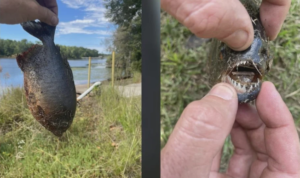
MOORE COUNTY -- The NC Wildlife Resources Commission is confirming a piranha was caught in Aberdeen Lake in Moore County!
The fish was caught by Chad Ray and the Commission says it was likely a pet that outgrew its tank and was tossed into the lake by its owners.
Biologists say they have no concern the species will establish itself in the lake. Piranha are warm water fish and will not survive the winter in North Carolina.
As a reminder: NC Administrative Code states it is unlawful to transport, purchase, possess, sell, or stock piranha in the state's public or private waters.
NCMS Joins Medical Societies Across Country Urging Congress to End Medicare Physician Payment Problems

RALEIGH -- The North Carolina Medical Society is joining more than 120 medical societies and the American Medical Association (AMA) to urge Congress to work with the physician community to enact long-term solutions to problems in the Medicare physician payment system. The letter also calls on Congress to take action to prevent scheduled Medicare payment cuts from going into effect next year.
In an article for HealthExec, the letter is outlined and includes new analysis which emphasizes the key point that Medicare physician payments have been reduced by 20 percent, adjusted for inflation from 2001-2021. The letter also notes that physicians are the only Medicare providers not receiving an inflationary update in 2023.
The AMA also contends that a discrepancy between what it costs to run a physician practice and the actual payments combined with the administrative and financial burden of participating in Medicare is incentivizing the ongoing healthcare market consolidation.
Medical societies outline Medicare payments action plan for Congress
In the letter to Congress, the national specialty and state medical societies detail why they are "deeply alarmed" about the mounting financial instability of the Medicare physician payment system. They are also asking lawmakers to take the following actions before the end of 2022:
• Provide relief from the scheduled -4.42 percent budget-neutrality cut in Medicare Physician Fee Schedule payments.
• End the statutory annual freeze and provide a Medicare Economic Index update for the coming year.
• Extend the 5 percent Advanced Alternative Payment Model (AAPM) participation incentive and halt the impossible-to-meet revenue threshold increase for five years to encourage more physicians to transition from fee-for-service into AAPMs.
• Waive the 4 percent PAYGO sequester triggered by passage of the American Rescue Plan Act.
The full article with more, in-depth analysis is available by clicking here.
The 2022 Golden Stethoscope Award Winners ARE...
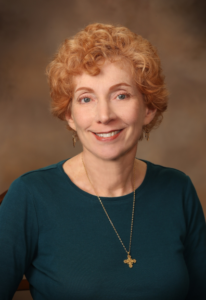
Dr. Lisa Kaufmann is a 2022 Golden Stethoscope Award winner!
After more than two years of sacrifice and hard work it is time to celebrate again! The North Carolina Medical Society is honoring physicians and PAs who went above and beyond during the COVID-19 pandemic. Each day this week we are announcing the winners. YOU can join them at the Golden Stethoscope Awards Gala on October 15.
More about Dr. Kaufmann:
Lisa Kaufmann, MD is the Medical Director of the Adult Inpatient and Emergency Department Service Line at Appalachian Regional Health Care System in the rural Blue Ridge Mountains. She is also the Medical Director of their Hospitalist Program, and Clinical Inpatient Faculty in the MAHEC Boone Family Medicine Residency . Dr Kaufmann came to love the Blue Ridge during her undergraduate and medical school years at Duke. Her Internal Medicine residency was at the University of Pennsylvania. After 8 years in private practice in Tucson, AZ, she joined the faculty of the University of Arizona, and late the State University of New York in Syracuse, from which she retired early as full professor to move to the mountains she loves. Dr Kaufmann’s academic focus is on quality improvement and clinical teaching. This past experience in rapid process improvement was particularly useful during the COVID epidemic, with the need to combine disaster preparedness, coordinating with emergency management including managing supply chain and physical plant adaptations, staffing shortages and having to develop clinical protocols and training in a small rural health system. Dr Kaufmann is also passionate about addressing social determinants of care, including coordination between the inpatient team and community services like the “Food is Medicine” program. When she is not working, Dr Kaufmann loves hiking in the mountains, writing, and hanging out with her large family.
Meet Dr. Kaufmann and our other Golden Stethoscope Award Winners on October 15 at the Raleigh Marriott Crabtree.
Here are our previously announced winners:
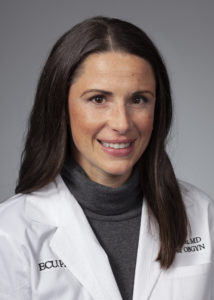
https://ncmedsoc.org/the-2022-golden-stethoscope-award-winners-are-3/

https://ncmedsoc.org/the-2022-golden-stethoscope-award-winners-are-2/
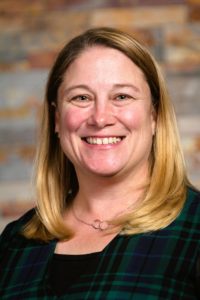
https://ncmedsoc.org/the-2022-golden-stethoscope-award-winners-are/
The 2022 Golden Stethoscope Award Winners ARE...

Dr. Allison Kerianne Crockett is a 2022 Golden Stethoscope Award winner!
After more than two years of sacrifice and hard work it is time to celebrate again! The North Carolina Medical Society is honoring physicians and PAs who went above and beyond during the COVID-19 pandemic. Each day this week we are announcing the winners. YOU can join them at the Golden Stethoscope Awards Gala on October 15.
About Dr. Crockett:
Dr. Crockett grew up outside of Charlotte and graduated from NC State in 2006. Crockett Attended Ross University School of Medicine and met her husband and graduated from there in 2012. She has been in Greenville since 2012 when she started her residency (formerly ECU/Vidant, now ECUHealth Medical Center). She graduated residency in 2016 and joined the faculty that year. Dr. Crockett is passionate about addressing the barriers to care and disparities in health outcomes the patients in our region face every day. She and her husband Adam have two little boys; Bradley (6, almost 7) and Alexander (3 and a half). Dr. Crockett lead the NC OB/GYN Society’s effort to pass protections for pregnant incarcerated women after a harrowing experience with a pregnant, shackled patient, which included the death of her patient’s infant.
NCMS will post it's final Golden Stethoscope winner on Friday! Here are links to our first two announced winners:

https://ncmedsoc.org/the-2022-golden-stethoscope-award-winners-are/

Suneya Gupta Hogarty, DO, FACOI
https://ncmedsoc.org/the-2022-golden-stethoscope-award-winners-are-2/
STD rates skyrocketing as pandemic comes to an end. Syphillis, gonorrhea, HIV all on the rise.

NEW YORK (AP) — Sharply rising cases of some sexually transmitted diseases — including a 26% rise in new syphilis infections reported last year — are prompting U.S. health officials to call for new prevention and treatment efforts. “It is imperative that we … work to rebuild, innovate, and expand (STD) prevention in the U.S.,” said Dr. Leandro Mena of the U.S. Centers for Disease Control and Prevention in a speech Monday at a medical conference on sexually transmitted diseases.
Infections rates for some STDs, including gonorrhea and syphilis, have been rising for years. Last year the rate of syphilis cases reached its highest since 1991 and the total number of cases hit its highest since 1948. HIV cases are also on the rise, up 16% last year.
And an international outbreak of monkeypox, which is being spread mainly between men who have sex with other men, has further highlighted the nation’s worsening problem with diseases spread mostly through sex.
David Harvey, executive director of the National Coalition of STD Directors, called the situation “out of control.”
Officials are working on new approaches to the problem, such as home-test kits for some STDs that will make it easier for people to learn they are infected and to take steps to prevent spreading it to others, Mena said.

Another expert said a core part of any effort must work to increase the use of condoms.
“It’s pretty simple. More sexually transmitted infections occur when people are having more unprotected sex,” said Dr. Mike Saag, an infectious disease expert at the University of Alabama at Birmingham.
Syphilis is a bacterial disease that surfaces as genital sores but can ultimately lead to severe symptoms and death if left untreated.
New syphilis infections plummeted in the U.S. starting in the 1940s when antibiotics became widely available. They fell to their lowest ever by 1998, when fewer than 7,000 new cases were reported nationwide. The CDC was so encouraged by the progress it launched a plan to eliminate syphilis in the U.S.
But by 2002 cases began rising again, largely among gay and bisexual men, and they kept going. In late 2013, CDC ended its elimination campaign in the face of limited funding and escalating cases, which that year surpassed 17,000.
By 2020 cases had reached nearly 41,700 and they spiked even further last year, to more than 52,000.
The rate of cases has been rising, too, hitting about 16 per 100,000 people last year. That’s the highest in three decades.
Rates are highest in men who have sex with men, and among Black and Hispanic Americans and Native Americans. While the rate for women is lower than it is for men, officials noted that it’s has been rising more dramatically — up about 50% last year.
That ties to another problem — the rise in congenital syphilis, in which infected moms pass the disease on to their babies, potentially leading to death of the child or health problems like deafness and blindness. Annual congenital syphilis cases numbered only about 300 a decade ago; they surged to nearly 2,700 last year. Of last year’s tally, 211 were stillbirths or infant deaths, Mena said.
The increases in syphilis and other STDs may have several causes, experts say. Testing and prevention efforts have been hobbled by years of inadequate funding, and spread may have gotten worse — especially during the pandemic — as a result of delayed diagnosis and treatment. Drug and alcohol use may have contributed to risky sexual behavior. Condom use has been declining.
And there may have been a surge in sexual activity as people emerged from COVID-19 lockdowns. “People are feeling liberated,” Saag said.
The arrival of monkeypox added a large additional burden. CDC recently sent a letter to state and local health departments saying that their HIV and STD resources could be used to fight the monkeypox outbreak. But some experts say the government needs to provide more funding for STD work, not divert it.
Harvey’s group and some other public health organizations are pushing a proposal for more federal funding, including at least $500 million for STD clinics.
Mena, who last year became director of the CDC’s Division of STD Prevention, called for reducing stigma, broadening screening and treatment services, and supporting the development and accessibility of at-home testing. “I envision one day where getting tested (for STDs) can be as simple and as affordable as doing a home pregnancy test,” he said.
FDA: Don't Cook Chicken in NyQuil!

Believe it or not, the FDA has been forced to issue a warning NOT to cook chicken in NyQuil. It is in response to a new, popular TikTok trend among young people. It comes on the heals of adolescents engaging in dangerous behaviors encouraged on the popular app, like eating Tide Pods.
In a statement, the FDA warns: “One social media trend relying on peer pressure is online video clips of people misusing nonprescription medications and encouraging viewers to do so too. These video challenges, which often target youths, can harm people — and even cause death,”
One recent challenge posted on social media encouraged people to cook chicken in a mixture of acetaminophen, dextromethorphan and doxylamine – the basic ingredients of NyQuil and some similar over-the-counter cough and cold products.

The Dangers of Social Media Challenges with Drugs
Because the teenage brain isn't fully developed, teens may act without understand consequences.
“Boiling a medication can make it much more concentrated and change its properties in other ways,” the FDA said. “Even if you don’t eat the chicken, inhaling the medication’s vapors while cooking could cause high levels of the drugs to enter your body. It could also hurt your lungs.”
The agency also pointed to a TikTok challenge daring people to hallucinate by taking large doses of the over-the-counter antihistamine diphenhydramine. Called the “Benadryl Challenge,” the FDA cited reports of teens ending up in hospital emergency rooms or dying after participating.
For doctors, it means that counseling your younger patients on the dangers of these popular challenges should be happening on each visit.
The FDA's warning, 'A Recipe for Danger: Social Media Challenges Involving Medicines' can be read in full by clicking here.
The 2022 Golden Stethoscope Award Winners ARE...

Dr. Suneya Gupta Hogarty is a 2022 Golden Stethoscope Award winner!
After more than two years of sacrifice and hard work it is time to celebrate again! The North Carolina Medical Society is honoring physicians and PAs who went above and beyond during the COVID-19 pandemic. Each day this week we are announcing the winners. YOU can join them at the Golden Stethoscope Awards Gala on October 15.
About Dr. Hogarty:
Dr. Suneya Hogarty is a native North Carolinian. After obtaining her undergraduate degree in religious studies from Davidson College, she attended Kirksville College of Osteopathic Medicine in Missouri, where she met her future husband, David. She completed her osteopathic Internal Medicine residency in Lansing through Michigan State University, and then moved to New Hampshire for Rheumatology fellowship at Dartmouth Hitchcock Medical Center.
She returned to Goldsboro in 2005 with 2 young sons to be closer to family. She has been serving Wayne county residents since that time. During the first fourteen years in Goldsboro, her family grew to include a daughter. In 2019, David and Suneya Hogarty opened their independent private practice, Integrative Arthritis and Pain Consultants (IAPC), with the goal of providing holistic osteopathic care to the whole person, since all disease affects mind, body, and spirit. Dr. Suneya integrates both Eastern and Western philosophy in her Rheumatology practice.
NC Sees Increase in West Nile Virus Activity

RALEIGH -- The NC Department of Health and Human Services is reporting an increase in cases of West Nile virus across the state. The four reported human cases is double the average number seen at this point in the year. The average by the end of August each year is two.
While the majority of people who become infected usually experience no symptoms or a mild, flu-like illness, about 20 percent of infected people will develop a fever, headache, body aches, joint pains, vomiting, diarrhea or rash. In about one percent of infections, WNV causes serious conditions, including encephalitis (inflammation of the brain), meningitis (inflammation of the membranes surrounding the brain and spinal cord) and meningoencephalitis (inflammation of the brain and surrounding tissues). WNV can lead to death in some cases.
Fall is the time of year when most cases of mosquito borne illnesses are reported, and with already higher-than-average cases, NCDHHS recommends the following:
- Use mosquito repellent that contains DEET (or equivalent) when outside in areas where mosquitoes might be present. Use caution when applying to children. See www.epa.gov/insect-repellents/find-repellent-right-you for repellants that will work for you and your family.
- Install or repair screens on windows and doors to keep mosquitoes outside. Or keep windows and doors closed and use air conditioning if possible.
- Reduce mosquito breeding by emptying standing water from flowerpots, gutters, buckets, pool covers, pet water dishes, discarded tires and birdbaths at least once a week.
- If you think you or a family member might have WNV disease, talk with your health care provider.
WNV is one of several mosquito-borne viruses which may infect people in North Carolina. Others include eastern equine encephalitis virus and La Crosse virus. Insect repellants are effective against the mosquito species that carry these diseases.
Wake County Medical Society Planning Visit to JC Raulston Arboretum

RALEIGH -- The Wake County Medical Society invites local colleagues to join them for an outdoor event. On Saturday, September 24, WCMS will visit the JC Raulston Arboretum in Raleigh. WCMS Members, Prospective Members, and Guests are invited to join a group tour at 10am, followed by a picnic lunch. Attendees are welcome to stay and tour the Fall for Orchids Show at the Arboretum.
The JC Raulston Arboretum, located in west Raleigh near the NC State Fairgrounds, is a local treasure. Their mission is to “introduce, display, and promote plants that diversify the American landscape, thereby benefiting our communities economically, environmentally, and aesthetically, as well as provide educational experiences to the general public, students of all ages, and the green industry.” We had a great time at the Koka Booth Amphitheatre last month. We endeavor to create more opportunities for the medical community to get to know one another outside of practice environments and the Arboretum is a venue that was suggested for such an outing.
Please send an email to [email protected] for details.
NCDHHS Releases New COVID-19 Vaccine Readiness Guidelines

RALEIGH -- The NC Department of Health and Human Services, NCAFP, NC Med, and NCMGMA have issued new reports on COVID-19 vaccines for physicians to utilize in the fall and winter months.
The include booster suggestions, pediatric dosing, allocation updates, training, and storage guidelines.
Here are the slides from the latest presentation:
Pediatrics Organization Share 9.16
North Carolina's Michael Jordan Keeps Breaking Records

(ESPN) -- It's not the last dance for a famous jersey after all!
A jersey worn by Michael Jordan in Game 1 of the 1998 NBA Finals -- part of the hallowed "Last Dance" season for Jordan that culminated with the Chicago Bulls reigning victorious over the Utah Jazz -- has sold for $10.091 million with auction house Sotheby's.
It is the most ever paid for an item of sports memorabilia, surpassing the $9.28 million paid in May for late soccer legend Diego Maradona's "Hand of God" jersey from the 1986 World Cup.
The "Last Dance" jersey marked Jordan's sixth and final NBA championship -- and his record sixth NBA Finals MVP award -- before he retired for the second time.
It is only the second Jordan jersey from the NBA Finals to ever appear at auction, according to Sotheby's. The previous record for any Jordan item was a 1997-98 Upper Deck Game Jersey patch card, with an on-card autograph, which sold for $2.7 million in October 2021.
Before the Maradona uniform, the most ever paid for a match/game-worn jersey was $5.64 million in 2019 for a Babe Ruth jersey, worn circa 1918-1920.
The previous record for any NBA jersey was $3.69 million, paid in May 2021 for one worn by Kobe Bryant during his 1996-97 rookie season.
Jordan graduated from Laney High School in Wilmington. He then played three seasons under coach Dean Smith with the UNC Chapel Hill Tar Heels. As a freshman, he was a member of the Tar Heels' national championship team in 1982.
One in 10 Physicians Consider or Attempt Suicide. No, You Didn't Read That Wrong.
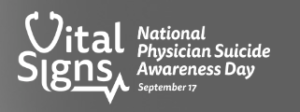
Burnout, depression, stress, hopelessness, and despair are increasingly words used by physicians as they face a new normal after the ravages of the COVID-19 pandemic. The result is that one in 10 have considered or attempted suicide. A new report from MedScape shows nearly a quarter of physicians are clinically depressed and over 60 percent suffer from colloquial depression (feeling down, blue, or sad). Responses to the survey of thousands of doctors include: "I am constantly depressed and looking for a way out," "I have little joy in performing (my) job," and "I'm tired of life."
Saturday, September 17, 2022, is National Physician Suicide Awareness Day. The day is a reminder and a call to action to take time to talk to colleagues, start conversations, and learn the signs.
There are 6 actions you can take. Click on any of these for tips:
- Learn the Signs
- Share Suicide Prevention Resources
- Prepare BEFORE a moment of crisis
- Check in with a physician
- Understand and remove structural barriers
- Create a culture of wellbeing
The North Carolina Medical Society is a supporting organization of National Physician Suicide Awareness Day. We are committed to ensuring our members feel safe in addressing their own mental health and wellness concerns. We look to raise awareness and create a culture of wellbeing. NCMS prioritizes efforts to reduce burnout, safeguard job satisfaction, and considers seeking mental health services a sign of strength.

North Carolina DHHS Secretary Kody H. Kinsley joins NCMS in supporting National Physician Suicide Awareness Day.
“Physicians play an essential role in the health and wellbeing of our communities across North Carolina," Kinsley says. "Passion-driven and caregiving roles, such as doctors and nurses, are some of the most susceptible to burnout and experience higher suicide rates - 40% higher for men and 130% higher for women - than that of the general public. For too long, the stigma surrounding suicide has been a barrier to many seeking out the services and treatment they need. Understanding the impact of suicide on every North Carolinian, including our physicians, is key to combatting stigma and shame. Talking about suicide saves lives.”
The American Medical Association is also weighing in with new research on physician burnout. A new study concludes COVID-19 pandemic exacerbated long-standing system issues that drive burnout
The burnout rate among physicians in the United States spiked dramatically during the first two years of the COVID-19 pandemic, according to a newly published study in Mayo Clinic Proceedings. Researchers found that 2020 marked the end of a six-year period of decline in the overall rate of work-induced burnout among physicians. By the end of 2021, after 21-months of the COVID-19 pandemic, the physician burnout rate spiked to a new height that was greater than previously monitored by researchers.
“While the worst days of COVID-19 pandemic are hopefully behind us, there is an urgent need to attend to physicians who put everything into our nation’s response to COVID-19, too often at the expense of their own well-being,” said AMA President Jack Resneck Jr., M.D. “The sober findings from the new research demand urgent action as outlined in the AMA’s Recovery Plan for America’s Physicians, which focuses on supporting physicians, removing obstacles and burdens that interfere with patient care, and prioritizing physician well-being as essential requirements to achieving national health goals.”
The new physician burnout research builds on landmark studies conducted at regular intervals between 2011 and 2021 by researchers from the AMA, Mayo Clinic and Stanford Medicine. Together, these studies found the overall prevalence of burnout among U.S. physicians was 62.8% in 2021compared with 38.2% in 2020, 43.9% in 2017, 54.4% in 2014, and 45.5% in 2011. Each study consistently demonstrated that the overall prevalence of occupational burnout among physicians were higher relative to the U.S. workforce.
Since 2012, the AMA has led the national conversation on solving the physician burnout crisis and advocated for new thinking and solutions that acknowledge physicians need support, system reforms, and burden reduction. The COVID-19 pandemic exacerbated many of the drivers of physician burnout. Research has shown that due to COVID-related stress, 1 in 5 physicians intend to leave their current practice within 2 years.
The AMA’s ongoing work to mitigate physician burnout, as exemplified by the Recovery Plan for America’s Physicians, strives to attack the dysfunction in health care by removing the obstacles and burdens that interfere with patient care. The AMA website offers physicians and health systems a choice of cutting-edge tools, information and resources to help rekindle a joy in medicine, including:
- STEPS Forward™ - a collection of more than 70 award‐winning online toolkits offered by the AMA that help physicians and medical teams make transformative changes to their practices and covers everything from managing stress and preventing burnout to improving practice workflow.
- Organization Biopsy™ - a set of measurement resources developed by the AMA that assess burnout levels within medical organizations to provide metrics that can guide solutions and interventions that mitigate system-level burnout rates and improve physician well-being.
- International Conference on Physician Health – a biennial meeting held this October in Orlando, Fla. that brings together the AMA, British Medical Association and Canadian Medical Association to support health and well-being in the ranks of physicians and medical students.
- Joy in Medicine™ Health System Recognition Program - an AMA distinction, now in its third year, that recognizes health systems with a demonstrated commitment to pursue proven strategies that reduce work-related burnout among care teams.
- Debunking Regulatory Myths – a series created by the AMA that provides physicians and their care teams with resources to reduce guesswork and administrative burdens and focus on streamlining clinical workflow processes, improving patient outcomes and increasing physician satisfaction.
The AMA continues to work on every front to address the physician burnout crisis. Through our research, collaborations, advocacy and leadership, the AMA is working to make the patient‐physician relationship more valued than paperwork, preventive care the focus of the future, technology an asset and not a burden, and physician burnout a thing of the past.
NCMS is dedicated to helping our members and to reducing the number of physician suicides in North Carolina and across the country. On our website you will find resources to improve your health and well being. Please visit it by clicking here.
If you, a colleague, friend, or loved one is considering suicide, please call the National Suicide & Crisis Hotline at 9-8-8 immediately.
"Earth is now our only shareholder." Patagonia founder gives away billion-dollar company to fight climate change

In a surprise move, Patagonia founder Yvon Chouinard announced he is giving away the multibillion-dollar business to help fight climate change.
The Wall Street Journal reports Chouinard and his family have transferred ownership of Patagonia to a trust and a nonprofit organization, saying Wednesday, titled “Earth is now our only shareholder.”
The company is famous for jackets, shorts and plaid shirts. Fleece vests are one of it's biggest sellers and have a cult following all of their own. Patagonia had annual revenue of $1 billion from 2017 to 2020.
Patagonia will remain a for-profit business under the new arrangement.
The full WSJ story is available by clicking here.
'Unidos: Inclusivity for a Stronger Nation! 2022 National Hispanic Heritage Month Begins

September 15 - October 15 is National Hispanic Heritage Month. It is a time to celebrate the contributions of people whose ancestors came from Spain, Mexico, the Caribbean, and Central and South America. It began in 1968 as a week-long celebration and expanded in 1988.
This year the theme is 'Unidos: Inclusivity for a Stronger Nation.' The Hispanic Heritage Month website says it wants to make sure that all voices are represented and welcomed to build stronger communities and a stronger nation.
The North Carolina Medical Society is grateful for our many Latinx members, staff, supporters and patients.
In North Carolina the Department of Health and Human Services works hard to support the state's growing Hispanic community including the NC Early Childhood Action Plan, the Office of Minority Health and Health Disparities, and by translating key content of the Division of Child Development and Early Education website.
For information on celebrations around the country and for places to learn more click here.
AMA to Congress: Doctors are Deeply Alarmed About Financial Instability of Medicare Physician Payment Plan

American Medical Association Director of Federation Relations Terri Otten is issuing a call for physicians to reach out to members of Congress as soon as possible. In a message to health care providers, Otten says "physicians must take the opportunity to once again remind (Congress) of the important work that needs to be completed during the lame duck session following elections."
Here is her full message:
Before members of Congress leave Washington, DC, for the mid-term election campaign season, physicians must take the opportunity to once again remind them of important work that needs to be completed during the lame duck session following the elections. In addition to shifting our grassroots programs into high gear, it is time for the House of Medicine to once again inform House and Senate leaders of the financial instability that Medicare physician payment policies will bring to practices throughout the nation in the coming year.
Specifically, we are asking Congress to do the following prior to scheduled Medicare payment cuts taking effect in 2023:
- Extend the Congressionally enacted 3 percent temporary increase in the Medicare physician fee schedule that was intended to offset budget neutrality adjustments for new office visit policies.
- Provide relief for an additional 1.42 percent budget neutrality cut that is planned for 2023 to offset new facility visit policies.
- End the statutory annual freeze and provide an inflation-based update for the coming year.
- Prevent a scheduled 5 percent payment cut for Advanced Alternative Payment Models (APMs) and the corresponding impossible-to-meet revenue threshold increase at the end of 2022.
- Waive the 4 percent PAYGO sequester triggered by passage of the American Rescue Plan Act.
Please let us know by noon on Wednesday, September 21, if your organization will sign on to the attached letter to House and Senate leadership asking them to address these scheduled cuts before the end of the year.
In addition, we encourage all specialty organizations and state medical societies to activate their grassroots between now and the end of the year. Supporting material developed by the AMA can be found by clicking here.
New Hanover-Pender County Medical Society Plans 25th Summer Social

The New Hanover-Pender County Medical Society is holding it's 25th Summer Social on September 21, 2022.
Following the COVID-19 pandemic, the Society is touting it's return as a great opportunity to reconnect with colleagues, meet new physicians and get advice from previous generations.
It is the 21st at Pine Valley Country Club from 6-9pm. A cash bar will be provided. RSVP by September 14, 2022.
Click here to reserve your spot.
Doctors Take Note: Is This A New Era for Cancer Screening?

Doctors around the world and here in the US are hailing the effectiveness of Galleri, a new blood test that can spot several cancers.
The Galleri test looks for Cancer DNA in the blood. The new Pathfinder Study found it detected dozens of new cases including many at an early stage and nearly three-quarters were forms of cancer not routinely screened for.
Doctors involved hope the test will save lives by detecting cancer early enough for surgery and treatment to be more effective, but caution that the technology is still in development.
Beyond spotting the presence of disease, the test predicts where the cancer is, allowing doctors to fast-track the follow-up work needed to locate and confirm a cancer.
Several publications have evaluated Galleri. Here are a few places to read more:
New Study: Covid-19 Illnesses Keeping at Least 500,000 Workers Out of U.S. Labor Force

A study released Monday shows that illness caused by Covid-19 shrank the U.S. labor force by around half a million people. It is a trend likely to go on if the virus continues to sicken workers at current rates.
The study estimates that workers with week-long Covid-19 work absences are 7 percent less likely to be in the labor force one year later compared to otherwise-similar workers who do not miss a week of work for health reasons.
The study is still not peer reviewed, but is considered conservative. It excludes anyone who wasn’t working at the survey’s outset but who would have become employed if not for illness. It also does not include those missing work to care for family members sickened by Covid-19, nor those who missed less than a week of work. The number could be as high as 750,000 people.
This could have an impact on the US economy. Economic growth depends on an expanding workforce and rising productivity. A slow-growing labor force means fewer people to build cars and wait tables, which could restrain the economy’s growth potential.
The study is broken down further in the Wall Street Journal. Read the full article here.
Melanoma Monday: Fun in the Mountains!

RALEIGH — All summer NCMS is bringing you tips to enjoy the great Carolina outdoors. Melanoma Mondays run weekly until Autumn with information from your fellow NCMS members.
Today it’s Dr. Maureen Aarons from Vision Dermatology in Raleigh with how to hike, canoe, and enjoy time in the North Carolina mountains and keep your skin looking great. Enjoy!

Maureen Aarons, MD
Have fun, enjoy the sun, and keep your skin looking great as you have fun in the mountains!
The clock is ticking down on summer, but North Carolina still has plenty of sunny days left this year. For many, that will mean time in the mountains. Dr. Maureen Aarons has three pieces of advice for you.
- Get high without sunburn! Elevation means you are closer to the radiation of the sun. Using UPF rated shirts, sleeves, gators, hats, jackets, and pants do double duty. They keep away sunburn and keep out bugs. Stock up on gear and go!
- Repel ticks and mosquitos by applying at least 20 percent (but no more than 30 percent) DEET (Deepwoods Off, Repel) or Picardin (12 hour Picardin). The EPA also approves IR355 PMD and oil of lemon eucalyptus to prevent tick bites, but essential oils won't cut it! Look for the EPA seal on the label.
- Get ahead of Poison Ivy and other itch/allergy causing plants by applying a protective barrier cream like Ivy Block (Bentoquatum) at least 15 minutes before going out. Wash all of your gear after being in a wooded area with gloves on!
If you would like to speak with Dr. Aarons for more advice you can contact her at Vision Dermatology by clicking here.
NY Gov. Kathy Hochul allowing polio vaccines after more virus detected in three counties
ALBANY, N.Y. (AP) — New York Gov. Kathy Hochul said Friday the state was stepping up its polio-fighting efforts after the virus was detected in the wastewater of yet another county in the New York City area.
The sample is genetically linked to the polio case from Rockland and provides further evidence of expanding community spread, state health officials said. The poliovirus had previously been detected in wastewater in New York City and three counties to its north: Rockland, Orange and Sullivan.
Hochul declared a state disaster emergency that allows EMS workers, midwives and pharmacists to administer polio vaccines and allows doctors to issue standing orders for the vaccine.
The lone confirmed case in New York involved an unidentified young adult who was unvaccinated.
Durham named one of America's underrated destinations (shhh... don't tell everyone!)

CNN -- Travel is back and Americans are headed to all the usual hot spots (proof: airports!). There remain, however, spots across the country that are still peaceful places to enjoy a trip without the crowds.
CNN has named 22 of the country's most underrated places to visit and Durham is on the list.
The article mentions the Durham Bulls and the area's vibrant scene and growing craft beer and distillery scene.
Of course, we already know Durham's charm!
Click here to find other places you may want to visit across the country.
In Case You Missed It: AMA Webinar, Dismantling Stigma for All: Addressing Physician and Patient Mental Health and Suicide Risk
In case you missed it, the AMA partnered with Christine Yu Moutier, MD, chief medical officer of the American Foundation for Suicide Prevention (AFSP) in New York to discuss dismantling the stigma around seeking mental health treatment. The webinar covered a wide range of topics critical to physician well-being.
American Medical Association CXO Todd Unger hosts.
Dial 9-8-8 if you or anyone you know needs help. The National Suicide Prevention Lifeline is now: 988 Suicide and Crisis Lifeline. It provides 24/7, free and confidential support for people in distress, prevention and crisis resources for you or your loved ones, and best practices for professionals in the U.S.
https://www.youtube.com/watch?v=Wb2nX1A_hWA

